As the days grow longer and the air begins to hum with warmth, our homes naturally open outward—inviting us to live more slowly, breathe in the morning light, and take our tea or wine outdoors. Whether you’re styling a sun-drenched terrace in the city, a country porch lined with lavender, or a minimalist deck tucked into a quiet meadow, spring and summer offer the perfect canvas for curating beauty in your outdoor living spaces.
This season is about soft layering, natural textures, and designing with a sense of ease. Wicker, linen, and terra cotta set the tone, while low, comfortable seating and wildflower touches bring soul. It’s less about over-decorating, more about crafting moments: a blanket tossed over a bench, a small stack of books on a side table, a single bloom in a handmade vase.
This post brings you inspiration from a range of styles and moods—each grounded in the same desire: to create peaceful, beautiful places to unwind and reconnect.
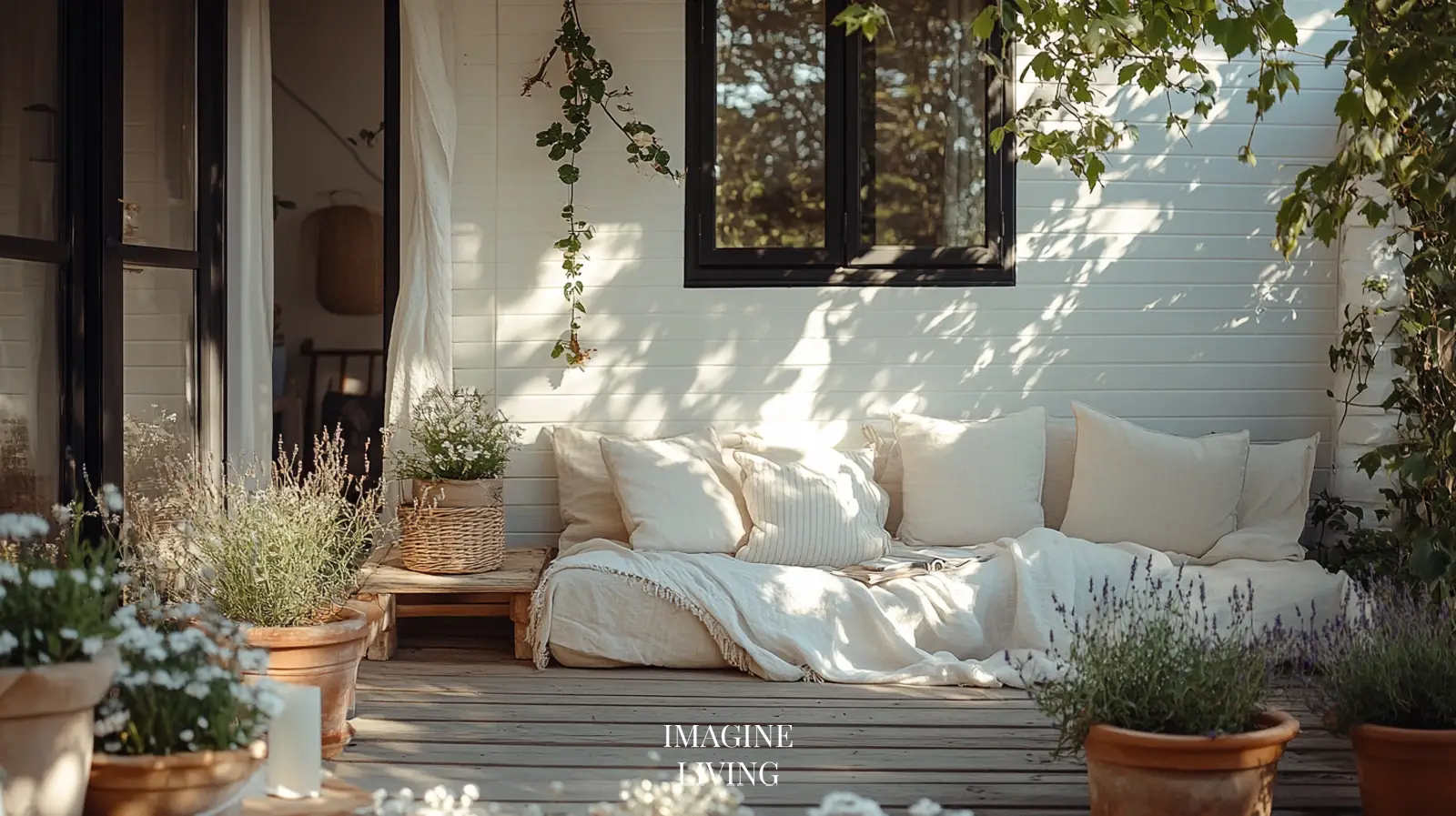
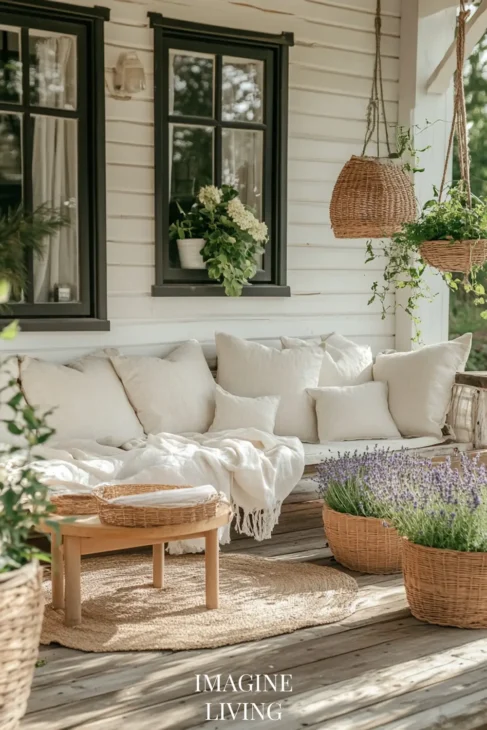
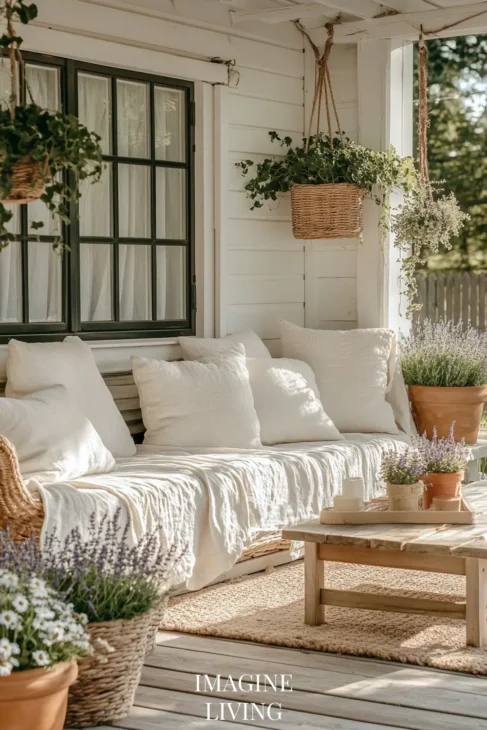
What Defines Spring/Summer Outdoor Styling in 2025?
Soft Minimalism & Texture-Led Design:
Whether you’re in the city or countryside, it’s all about tactile softness—linen cushions, woven rugs, and low-slung furniture that invites lounging.
Layered Nature:
Lavender, chamomile, olive branches, and wild herbs—nature plays both backdrop and focal point. Group potted plants with varied heights and textures for a lush, organic effect.
Mood Lighting & Warm Accents:
Battery-powered lanterns, sculptural candles, and soft globe lights add romance at twilight. Mix rattan with concrete or wood for a look that feels both grounded and elevated.
Neutral Color Palettes with Soul:
Creams, beiges, terracotta tones, and warm greys make spaces feel breathable and timeless.
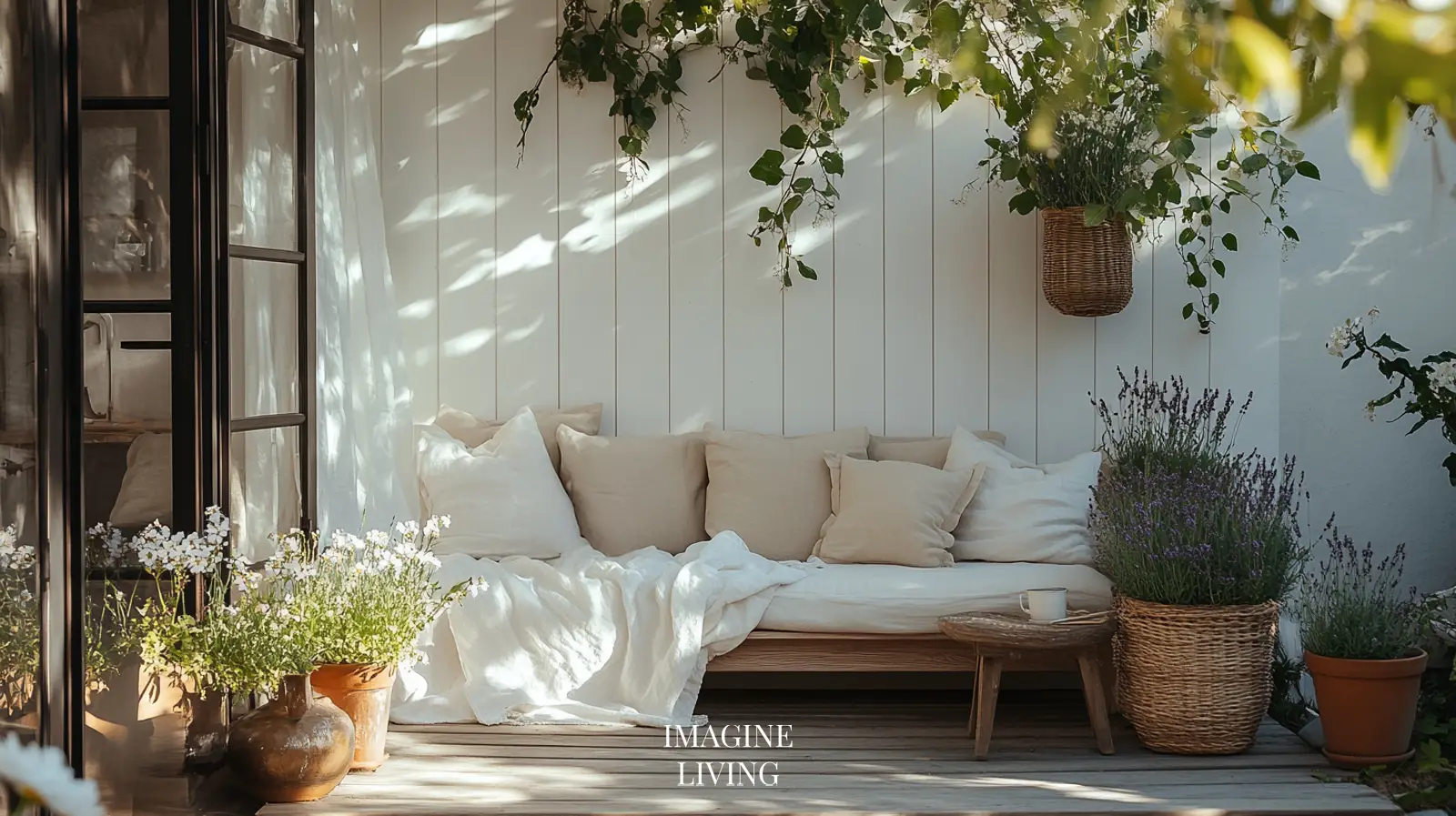
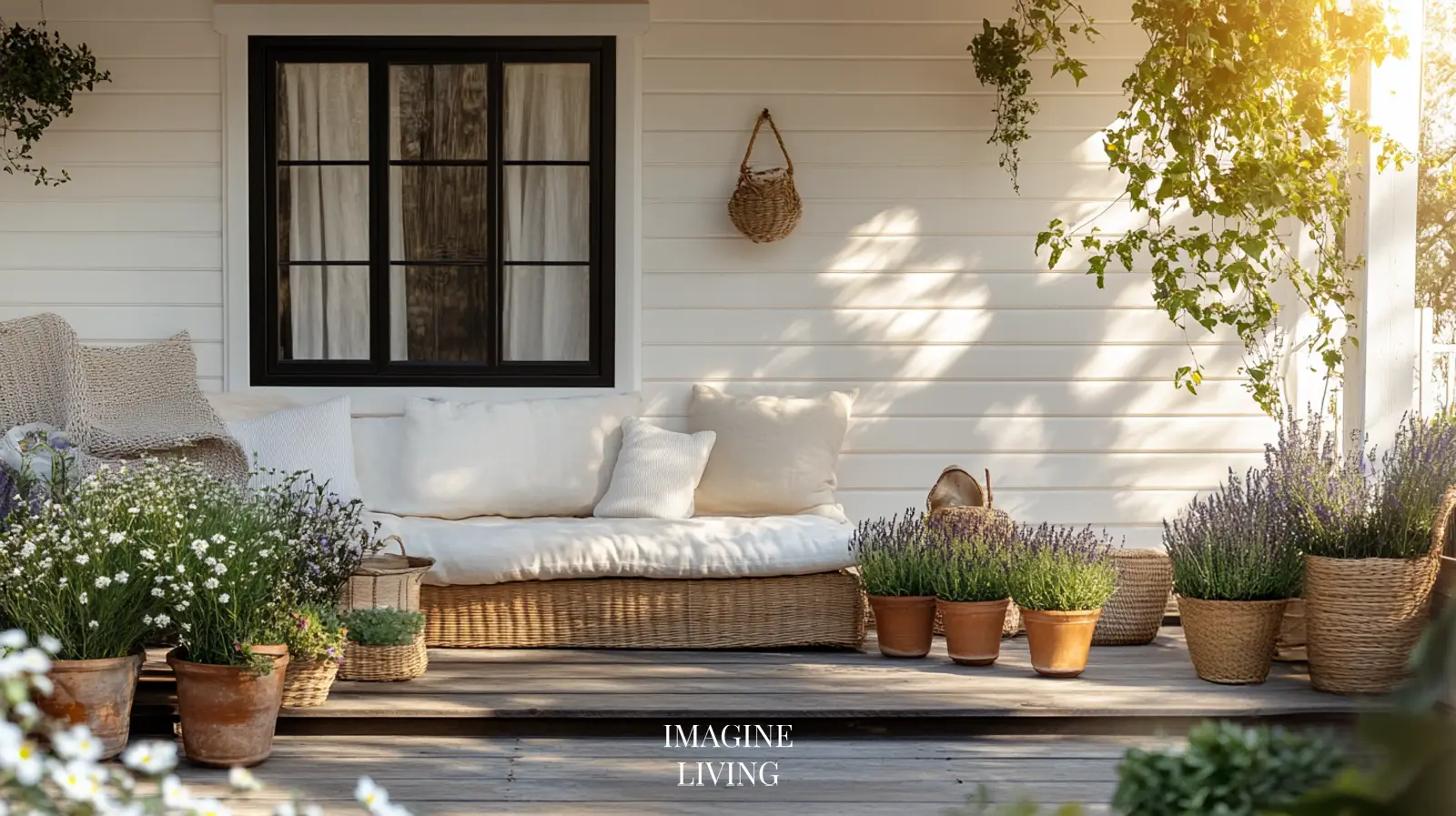
Scandinavian-Inspired Porches & Decks: Minimal and Grounding
Scandinavian spring styling leans into pared-back serenity. Think creamy white linen, pale woods, and leafy greens dancing in the breeze. Built for light and air, these spaces often reflect a peaceful connection with nature.
Key elements:
- Low wooden platforms or benches
- Layered linen throws and cushions in ivory and beige
- Woven baskets with lavender or rosemary
- Hanging planters or simple wall sconces for soft glow
- Understated ceramics or stoneware for functional styling
Design tip: Keep the palette monochrome but mix textures: smooth linen, rough wood, soft lavender, matte pottery. This gives depth without visual clutter.

Shop the Look
This post contains affiliate links. If you purchase through these links, we may earn a small commission at no extra cost to you. As an Amazon Associate, we earn from qualifying purchases. Thank you for your support!
What Defines a Scandinavian-Inspired Porch?
Scandinavian-style porches offer a quiet kind of luxury—rooted in simplicity, light, and connection to the natural world. These spaces are not over-styled or polished, but thoughtful and intentional. Every element has a role, whether it’s a linen throw draped on a bench or a cluster of lavender pots catching the afternoon light.
What makes them distinctly Scandi is not the absence of decor, but the presence of atmosphere. It’s a blend of serenity and soul—where textures soothe, light dances, and time feels slower.

Key Elements of a Scandinavian Porch
Linen and Cotton Textiles:
Soft to the touch and light in tone—beige, ivory, stone, or warm gray—textiles add both comfort and warmth. Layering cushions and throws is essential for softness and lived-in charm.
Natural Wood:
Pale or weathered wood is a foundational material. From benches to decking, wood brings a grounding, elemental quality that never overwhelms.
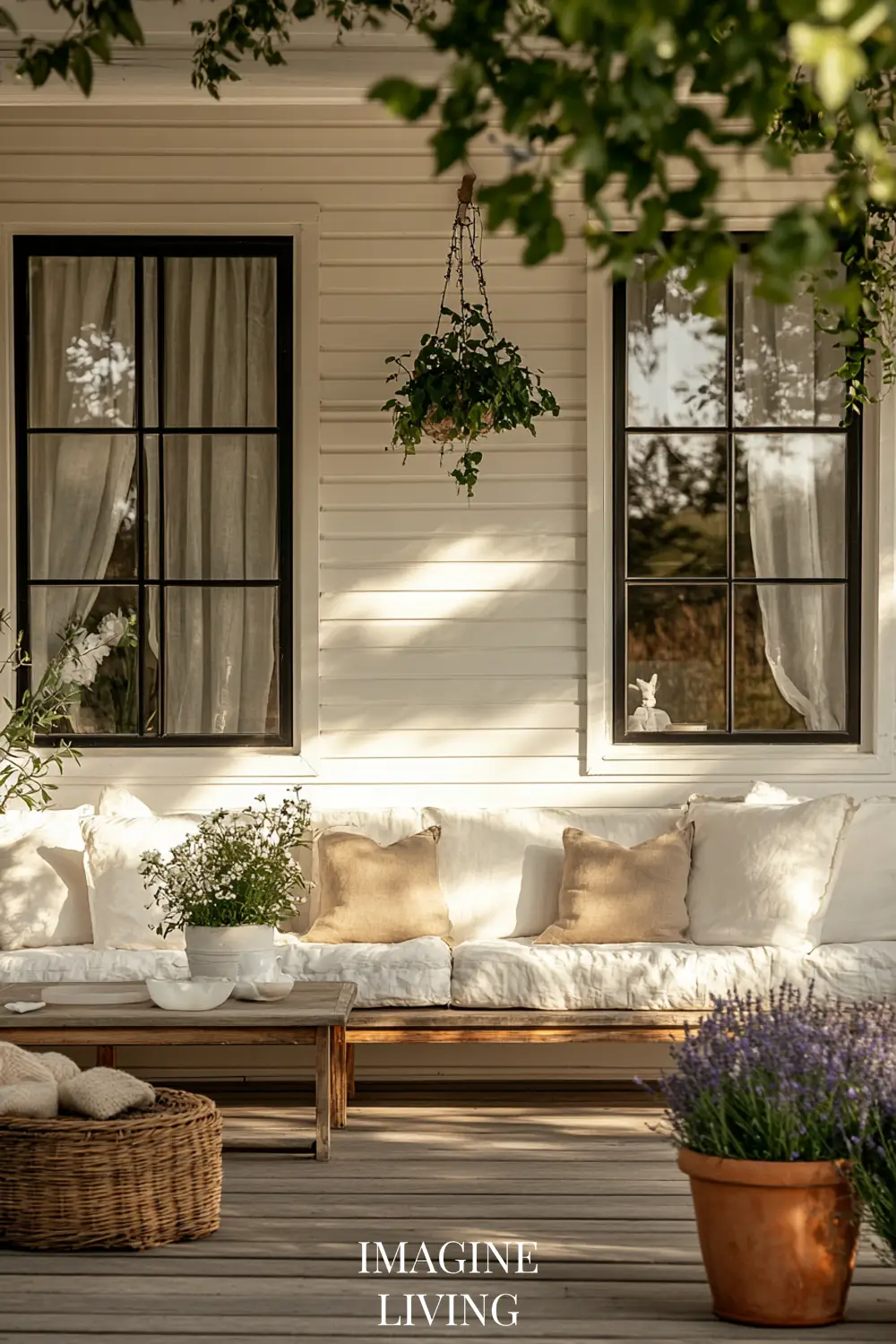
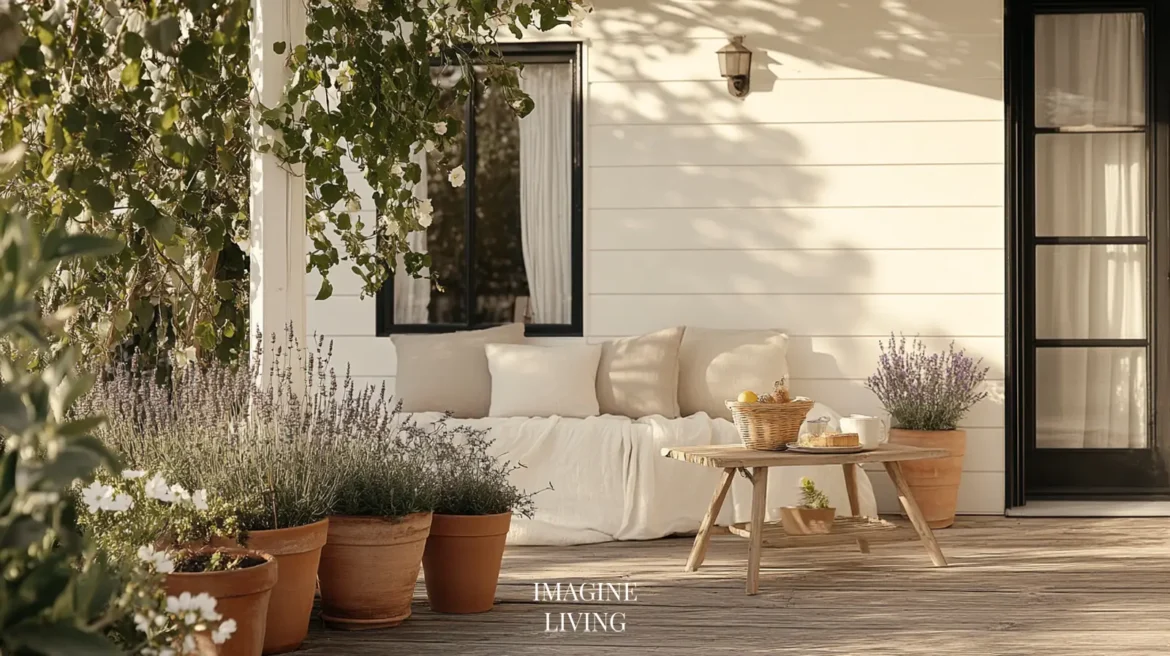
Woven Accents:
Rattan, wicker, jute, or seagrass—in the form of planters, poufs, or rugs—add rustic texture and natural rhythm to the space.
Herbs and Greenery:
Lavender, thyme, rosemary, and small olive trees make beautiful (and fragrant) companions. Plants are often grouped asymmetrically and placed in terra cotta or natural clay pots.
Artisanal and Imperfect Touches:
A handmade ceramic vase, a hanging planter, a slightly lopsided mug—all these add warmth and individuality.
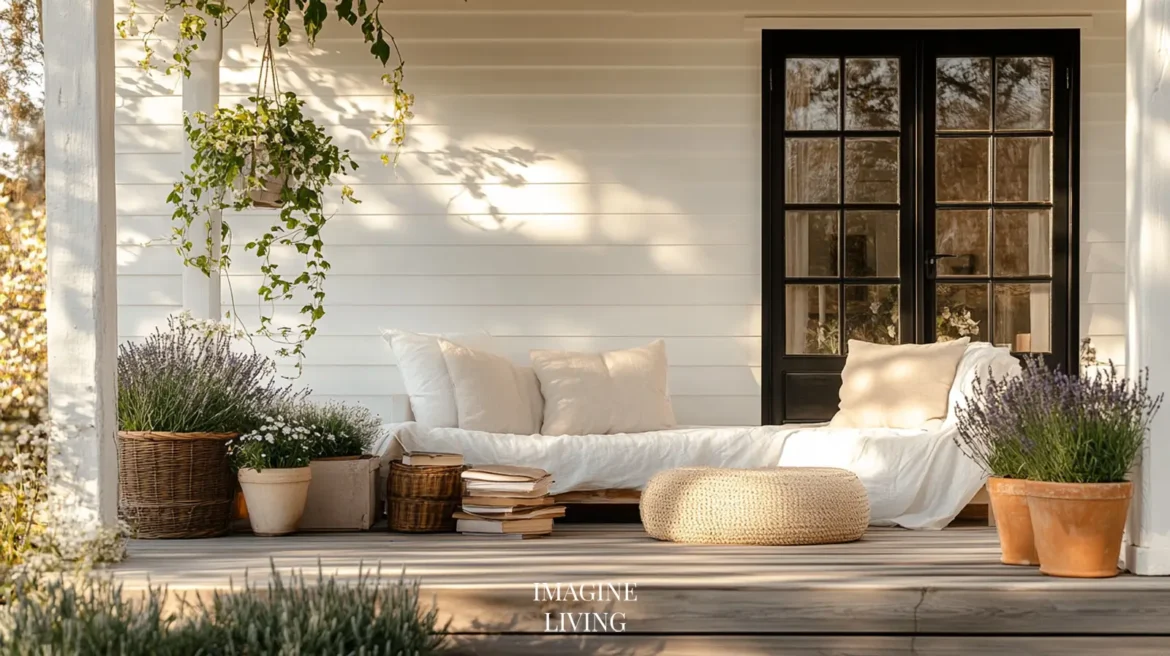
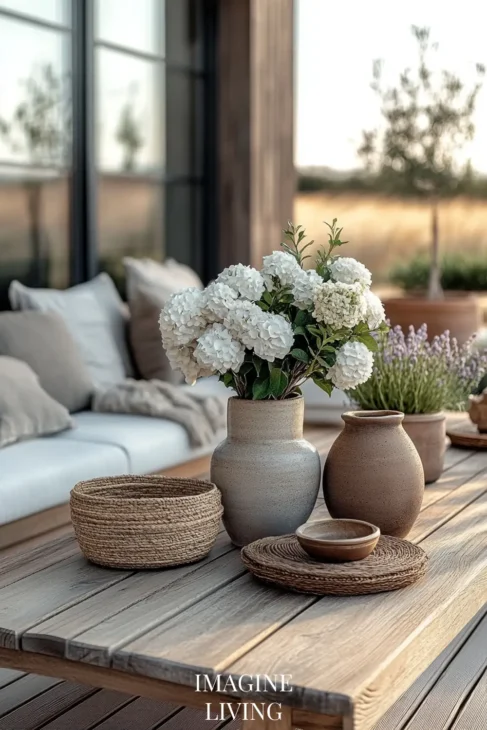
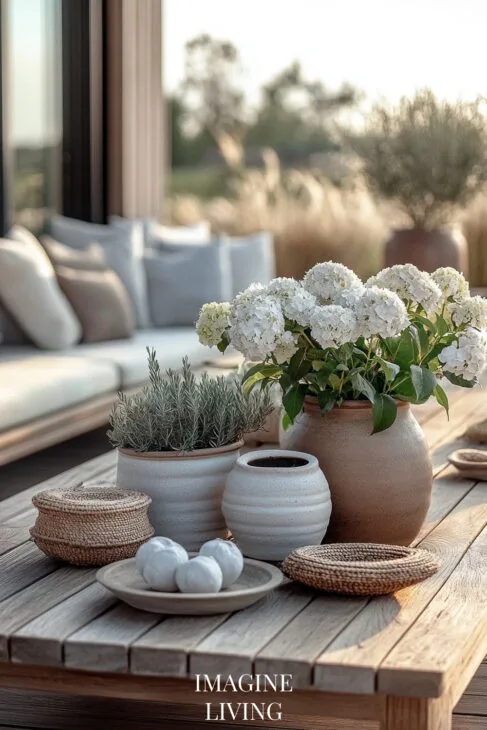
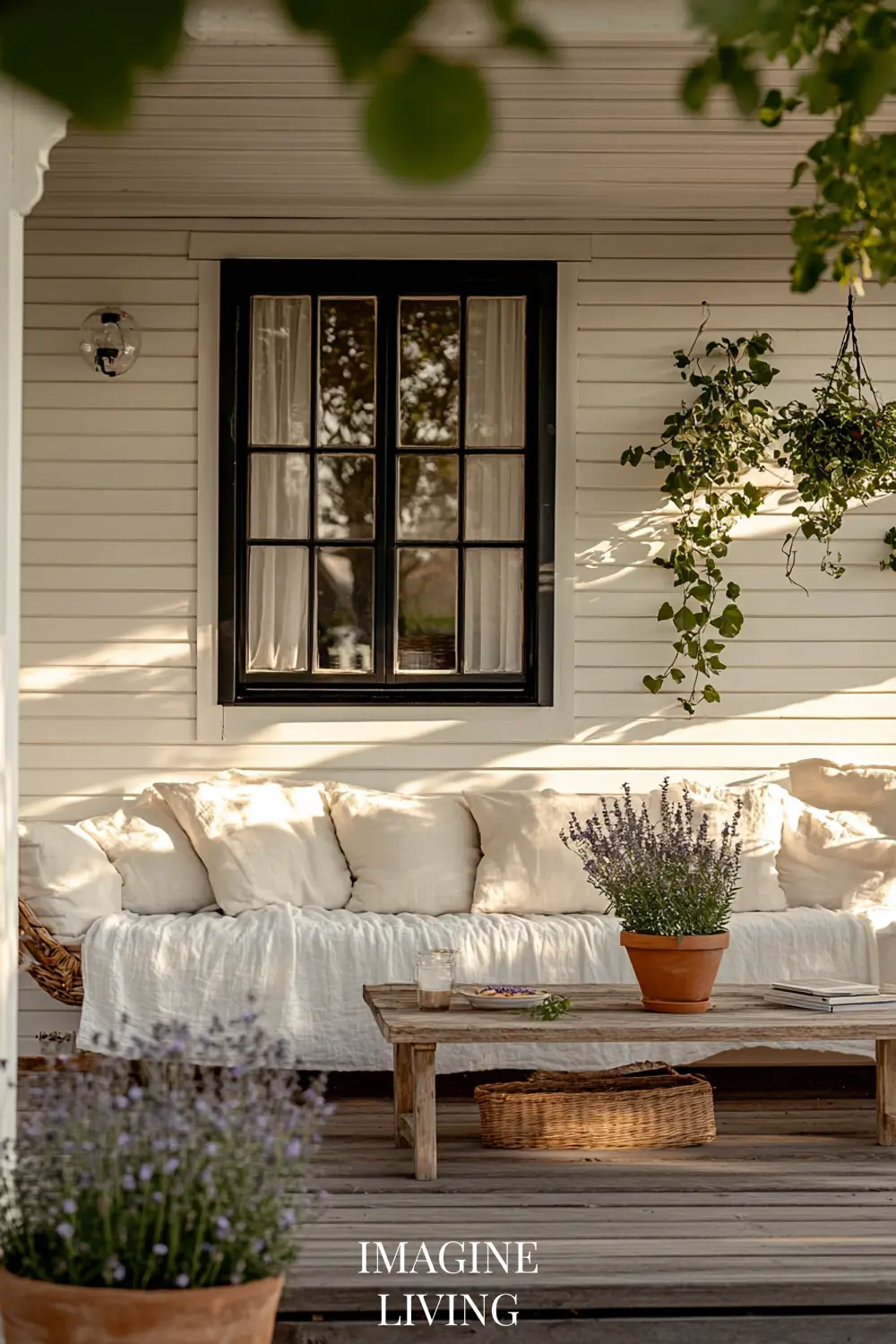
Filtered Light and Shadow Play:
Dappled sunlight through trees, linen curtains, or pergola beams creates ever-changing patterns. In the evening, soft candlelight or solar lanterns replace harsh overheads.
Scandinavian porches capture the spirit of the season: fresh, grounded, and intimately in tune with the outdoors.

General Styling Tips for Scandinavian Porches
Think in Layers:
Scandi design is about layering softness over structure. Start with a jute or cotton rug, then add cushions of varying sizes and fabrics. Use throws with loose weaves or subtle texture to create visual interest and tactile contrast.
Keep the Palette Earthy and Soft
Stick to whites, oat tones, dusty browns, muted sage, and gray-beige. A soft, chalky palette allows your natural textures to shine. Pops of color—if any—come from potted herbs or seasonal blooms.
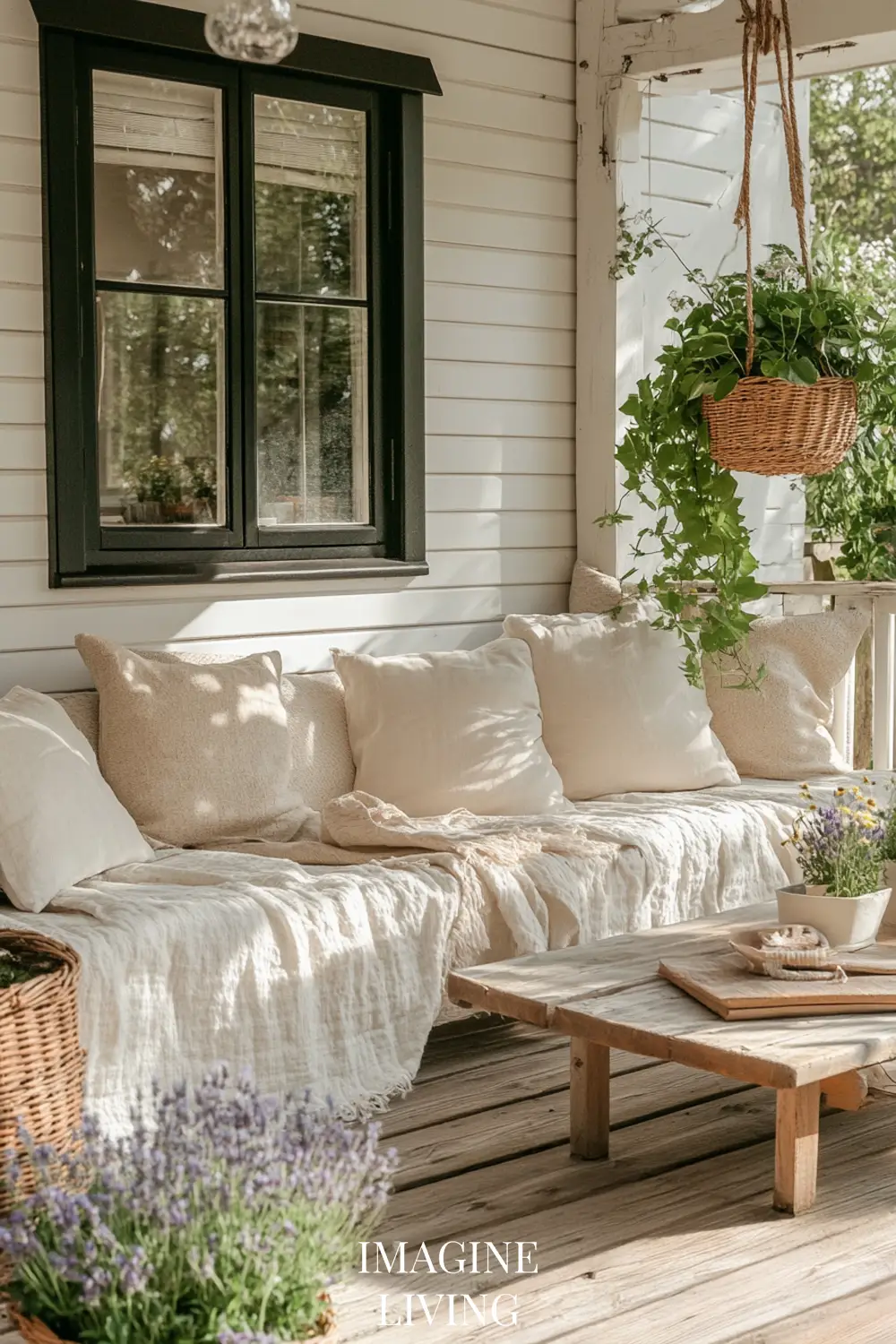
Play with Asymmetry
Don’t feel the need to center everything. A low bench with three pillows of different sizes, a hanging plant off to one side, or mismatched planters in staggered heights—all these give the porch a more relaxed, lived-in charm.
Embrace Negative Space
Scandi design breathes. Leave small pockets of space untouched. This allows each object to be noticed and gives the eye room to rest. A single branch in a vase often makes more impact than a busy bouquet.

Let Light Do the Styling
Use light as a design tool. If natural sunlight plays across your bench during golden hour, lean into it. In the evening, swap overhead bulbs for table lanterns, oversized candles, or fairy lights tucked into planters. The result? Instant intimacy.

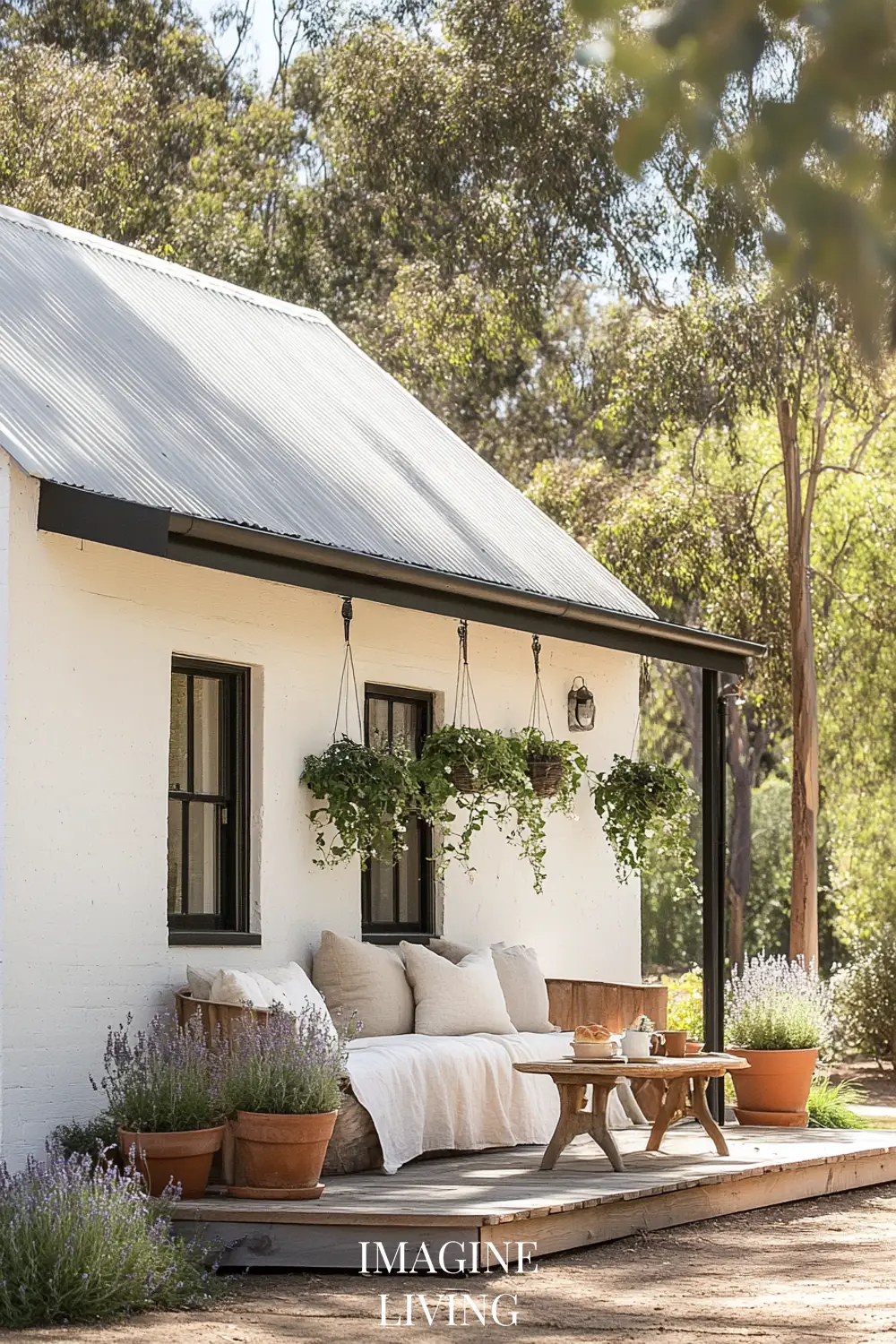
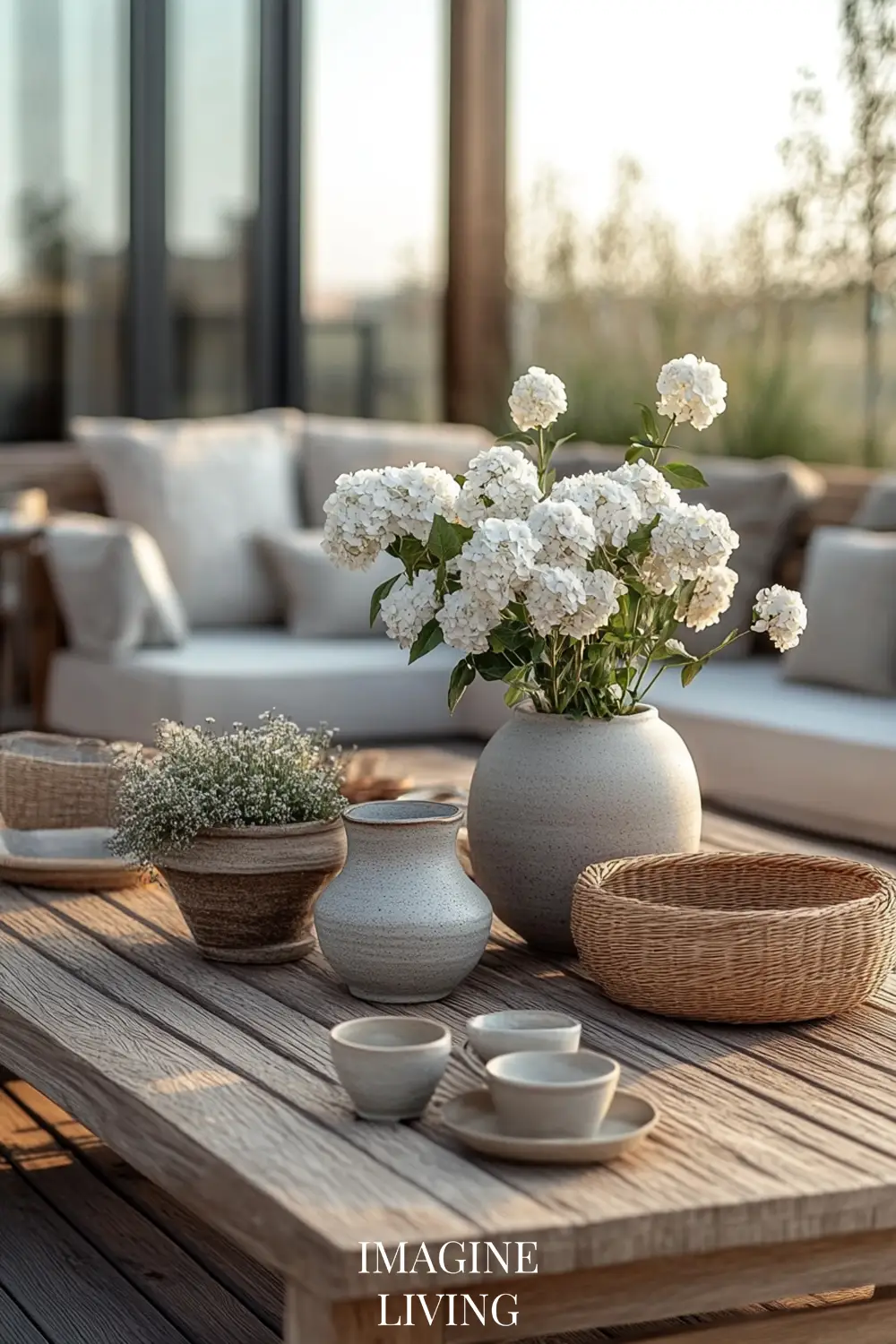
Mistakes to Avoid in Scandinavian Porch Styling
Overfilling the Space
Scandinavian style thrives on intention. Avoid cluttering your porch with too many planters, mismatched decor, or excessive accessories. Each piece should have breathing room and purpose.
Using Too Much Color
Bright colors can disrupt the soft serenity. Stick to muted, earthy hues. A vibrant pink throw or neon lantern will feel jarring in a Scandinavian palette.
Glossy or Synthetic Finishes
Shiny plastics or metallics can break the natural aesthetic. Opt for matte or raw textures—natural wood, ceramic, linen, or powder-coated metal.
Neglecting Light Levels
Harsh lighting, especially cool-toned or overly bright, can destroy the soft atmosphere. Always choose warm, low light sources like lanterns or candles in tinted glass.
Making It Too Minimal
Scandi isn’t sterile. Don’t strip everything away. A little imperfection—a wrinkled throw, a branch with uneven leaves—is part of what makes it warm and human.

Parisian & Urban Rooftops: Elevated Charm
Rooftop terraces in cities like Paris or New York marry clean lines with curated softness. It’s all about creating intimacy within an expansive view. Here, structured greenery meets tactile comfort.
Look for:
- Boxwood or olive trees in oversized planters
- Low seating with tailored cushions
- Subtle lighting—small orb lights or linear fixtures
- A woven rug underfoot to define the space
- Small herb gardens in pots
Design tip: Mix structured forms (square coffee tables, modern pots) with loose, billowy fabrics to create that contrast of sophistication and soul.
What Defines a Parisian Rooftop?
Parisian rooftops are a romantic escape above the city. They feel elegant yet intimate—never overdone, always effortlessly composed. These spaces borrow from the charm of old-world architecture, but with a modern Parisian twist: structured greenery, subtle detailing, and moments of visual poetry.
What sets a Parisian rooftop apart is the quiet balance between refinement and lived-in warmth. It’s a place for espresso in the morning light or a candlelit apéritif as the sky turns lavender. Style is important, but soul is everything.

Key Elements of a Parisian Rooftop
Tailored Furniture:
Cushioned bistro chairs, curved metal benches, and low-set sofas give structure without feeling formal. Look for clean silhouettes with traditional detailing.
Natural Stone and Patina:
A stone ledge, tiled flooring, or aged concrete adds authenticity. Surfaces feel time-worn and quietly refined.
Architectural Greenery:
Olive trees in large planters, boxwood, lavender in terracotta—plants are sculptural and tidy, with a sense of height and form.
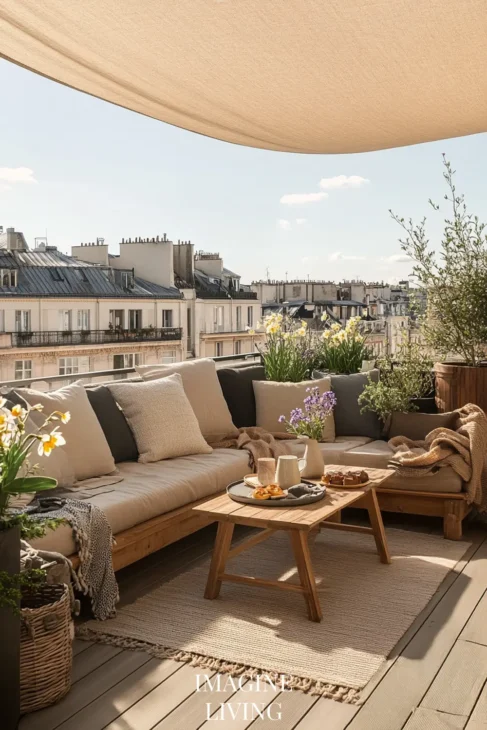
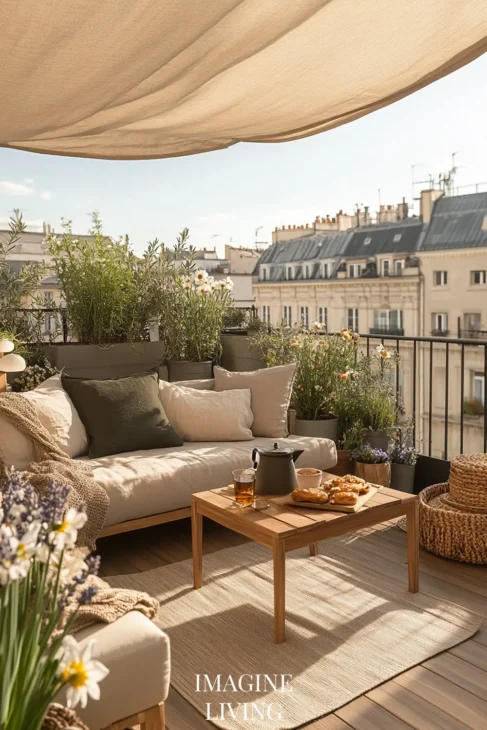
Muted Romantic Palette:
Soft grey, white, taupe, and faded black are the core tones. Brass or gold may appear in lighting or planters for a soft gleam.
Small, Special Details:
Vintage candleholders, a marble tray, a weathered ceramic vase—details feel collected, not purchased all at once.
Deliberate Lighting:
Nothing harsh. Opt for tinted-glass lanterns, battery-operated globe lights, or string lights draped elegantly over a pergola or railing.

General Styling Tips for Parisian Rooftops
Blend Old with New
Pair clean-lined furniture with vintage accents. A sleek sofa and a patinated iron lantern can co-exist beautifully.
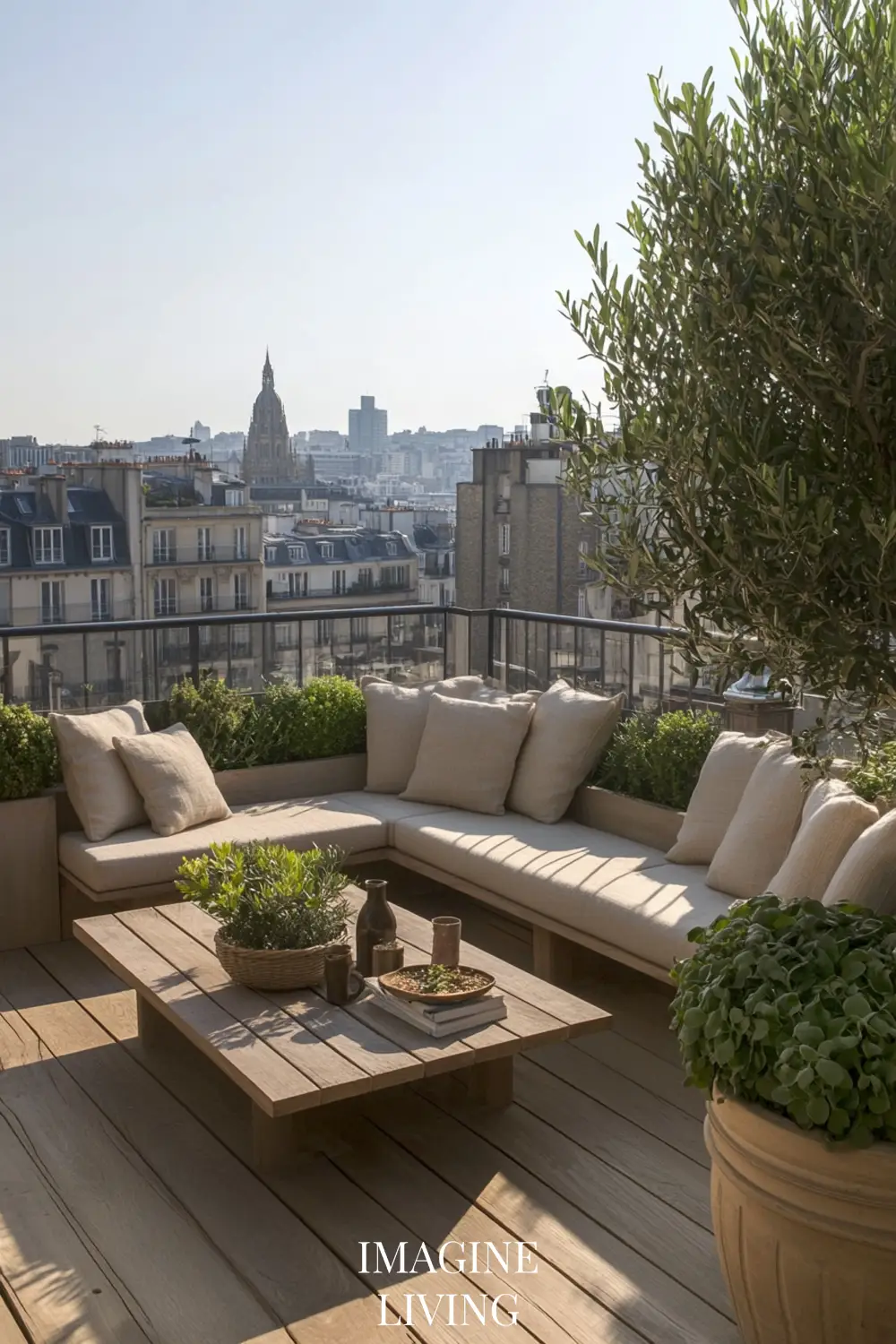
Layer with Restraint
Use textiles—pillows, throws, rugs—but keep the mix elegant. Linen, velvet, or washed cotton work best. Avoid excess ruffles or prints.
Focus on Symmetry and Shape
Parisian style appreciates balance. Mirror planters on either side of a bench or flank your table with twin lanterns.
Use Vertical Space Thoughtfully
Let vines climb a railing or install a hanging planter to draw the eye upward and enhance the view.
Add a Touch of Glamour
A brass tray, cut glass, or a candle in a smoky hurricane adds subtle romance without overpowering the space.
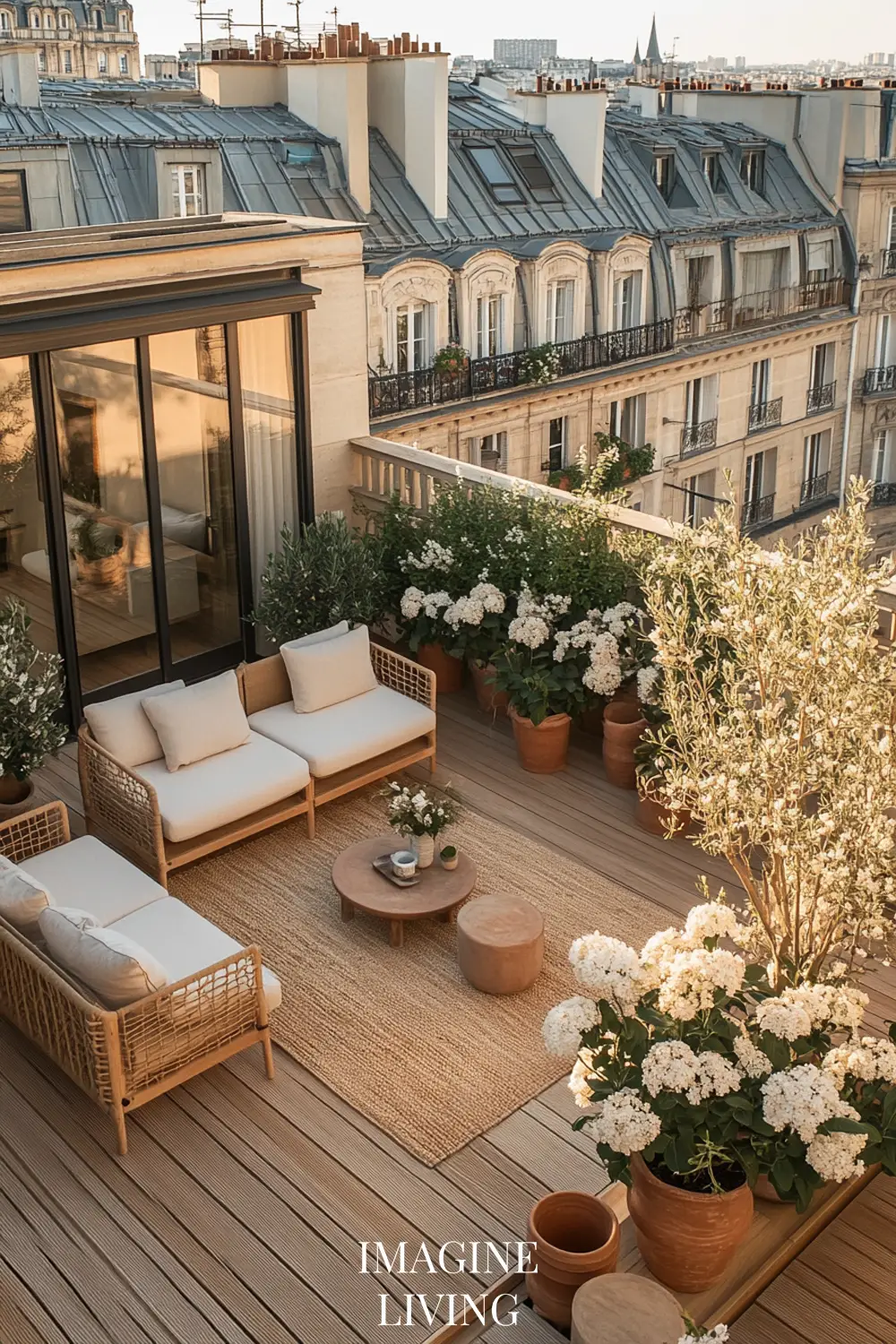
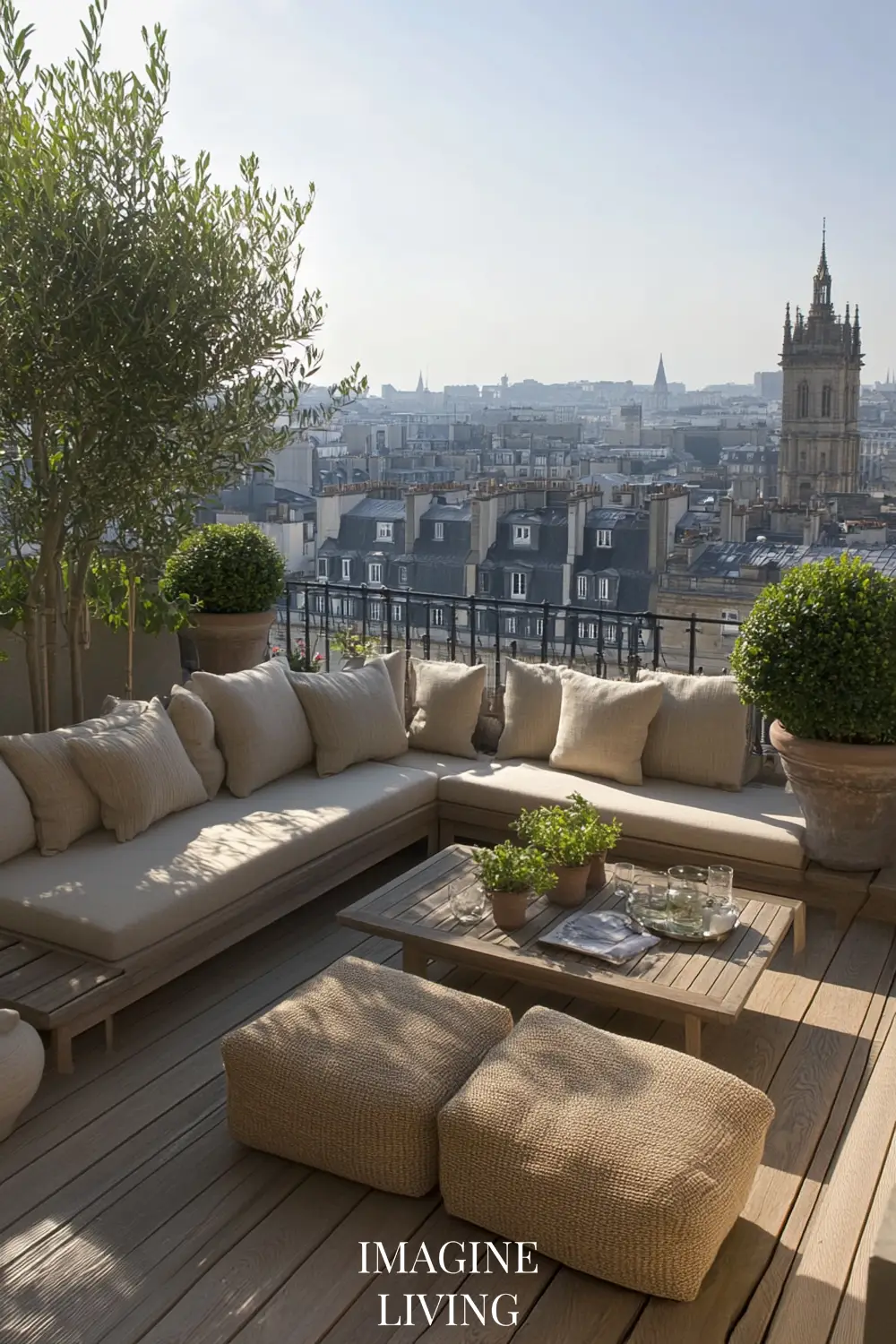
Mistakes to Avoid in Parisian Rooftop Styling
Overdoing the Vintage Theme
Keep it chic. Don’t go full flea-market. Choose one or two antique-style pieces to anchor the mood.
Using Bright or Loud Colors
Stick to neutrals and soft hues. Anything too bold breaks the poetry of the scene.
Forgetting Comfort
Beauty is essential, but it’s still a place to lounge. Choose cushions and seating that truly invite lingering.
Making It Too Cluttered
Parisian rooftops love open space. Leave a portion of the floor plan open to enjoy the sky, light, and movement.
Harsh Lighting Fixtures
No fluorescent bulbs or cold tones. Warm ambient light creates the mood—day or night.
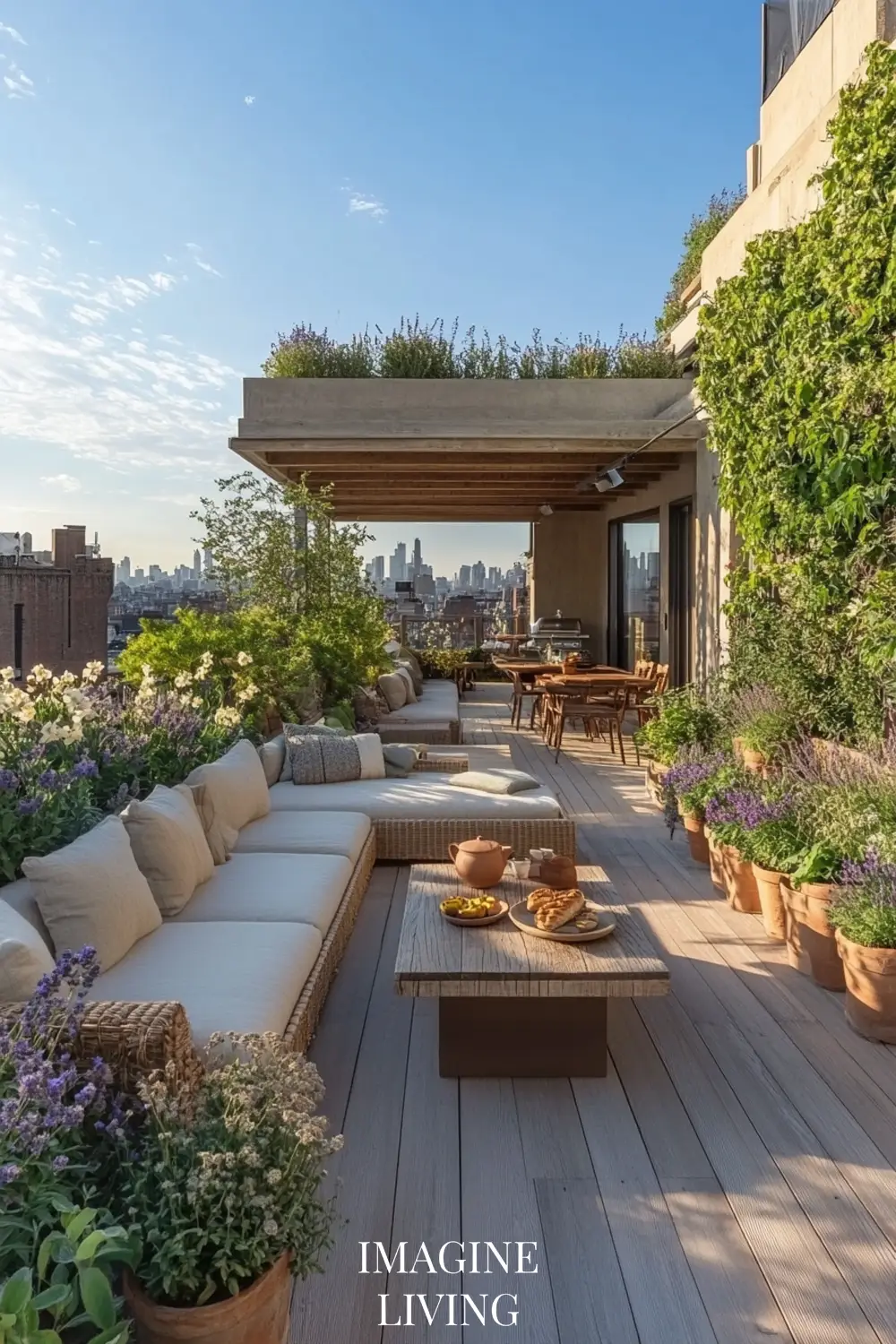
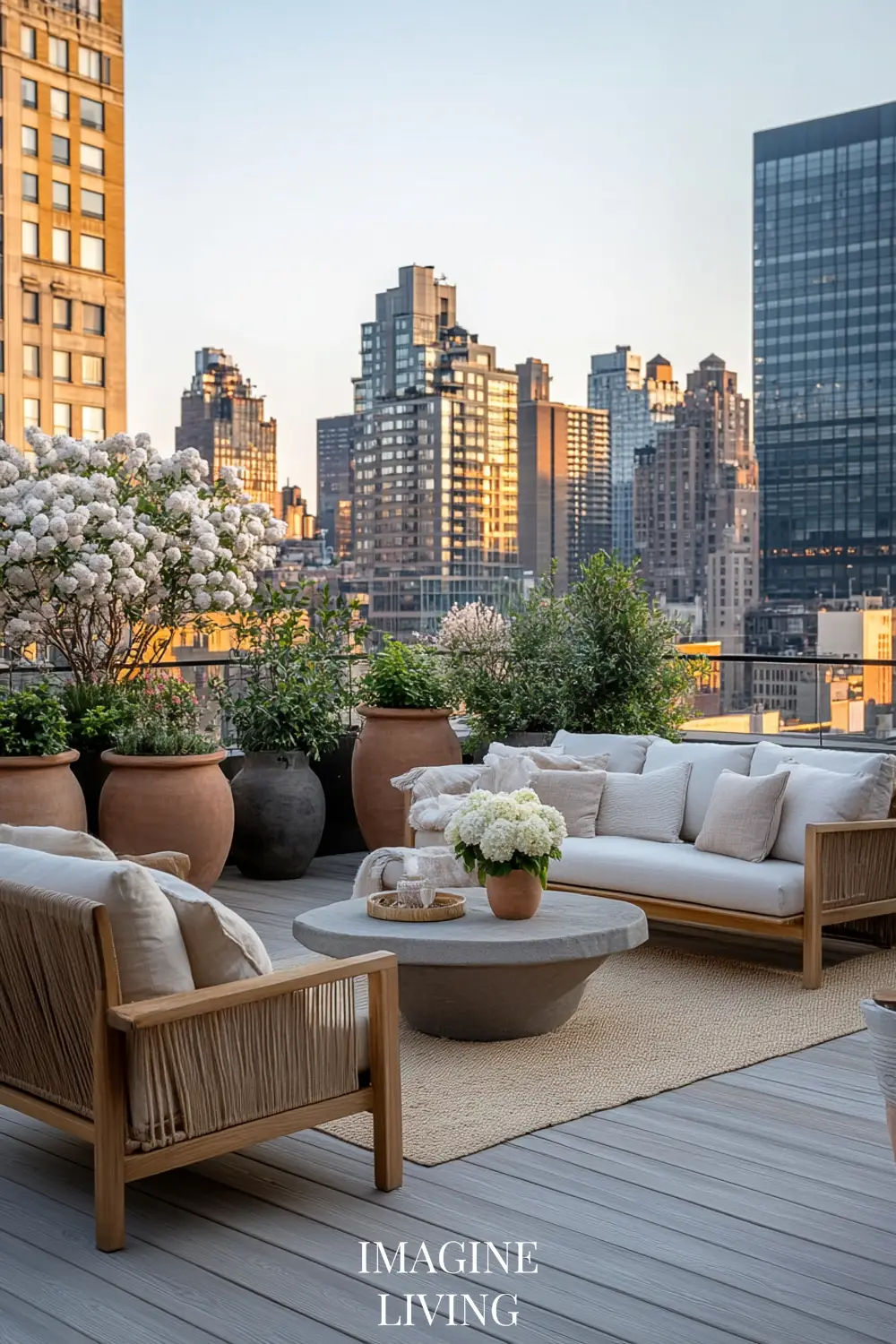
Modern Urban Terrace: Calm Among the Concrete
Modern city terraces are sanctuaries above the noise. Designed with clean lines, lush greenery, and cozy materials, they balance function and aesthetic for contemporary living.

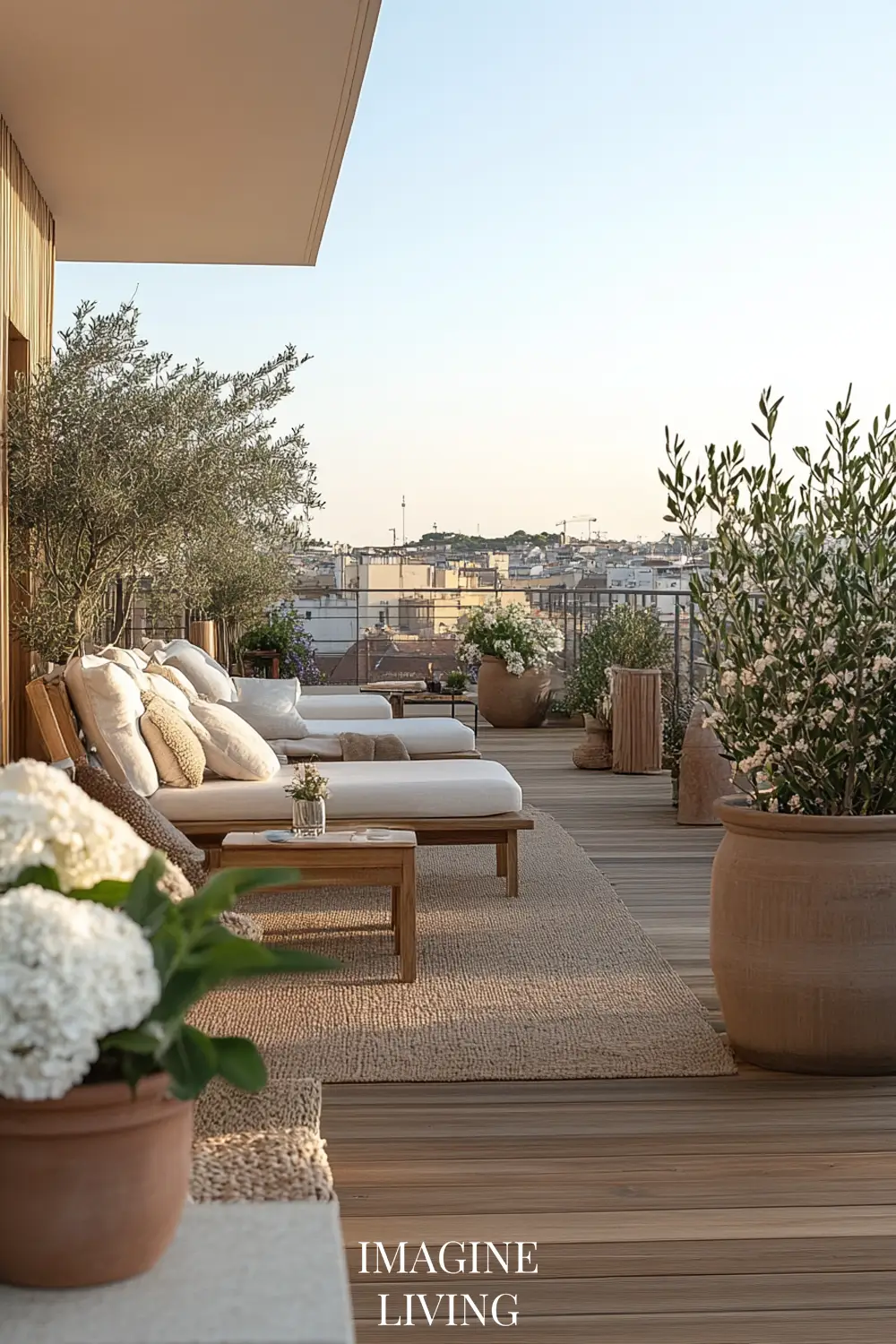
What Defines a Modern Urban Terrace?
Modern urban terraces are a quiet rebellion against the chaos of city life. Elevated above the hum of traffic and noise, these outdoor spaces become serene escapes—private, stylish, and deeply calming. They’re built around clean lines, neutral palettes, and intentional design that favors simplicity over excess.
What defines a modern city terrace is not its size but its mood: controlled, calming, and uncluttered. Every element, from the sleek furniture to the vertical plant wall, is chosen for a reason—to maximize comfort and style in a minimal footprint.
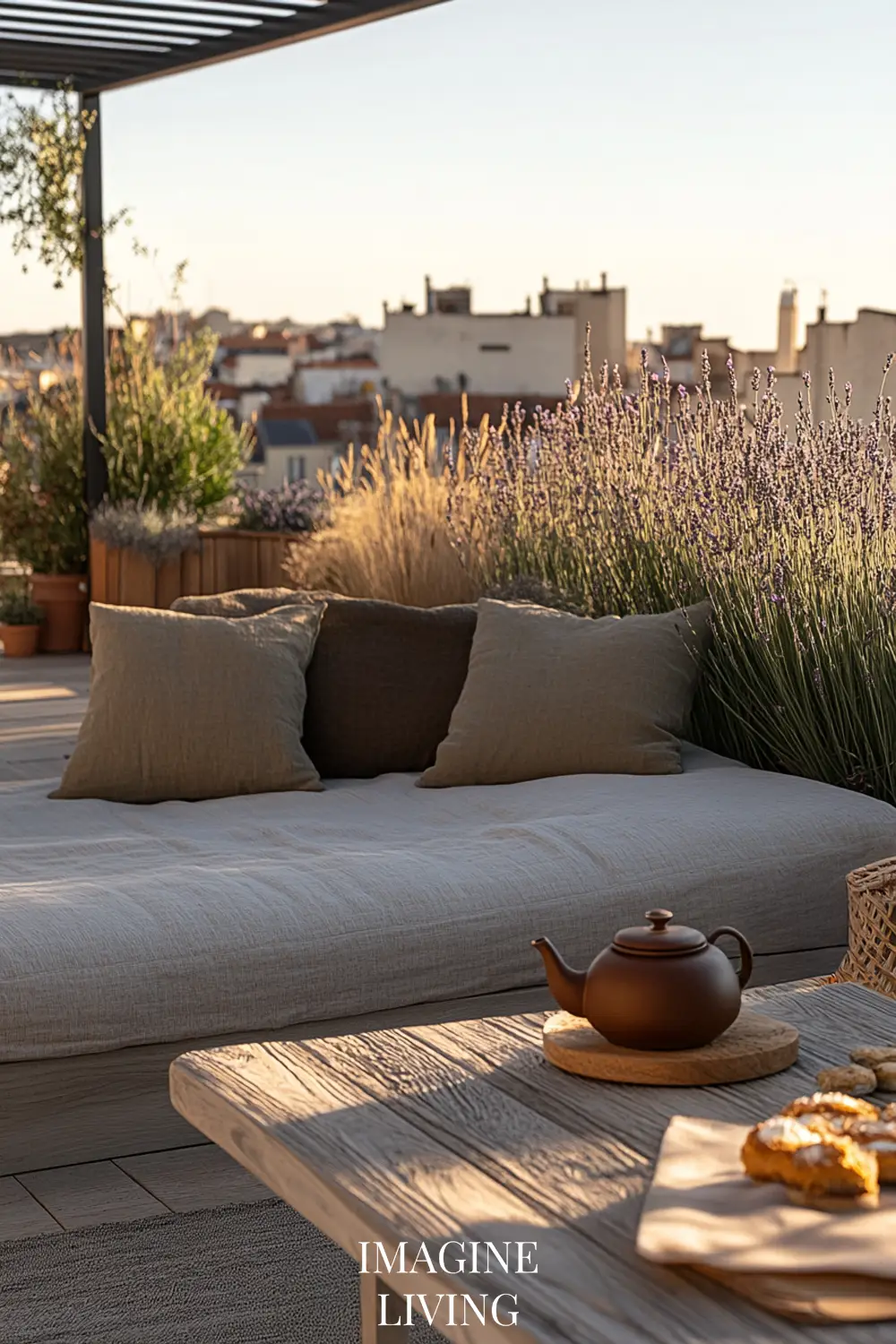
Key Elements of a Modern Urban Terrace
Streamlined Furniture:
Metal, teak, or powder-coated aluminum pieces with clean, geometric forms. Low-profile lounges, modern sectionals, or sleek bistro sets define the space.


Natural Accents with Structure:
Planters in matte black or terracotta filled with tall grasses, olive trees, or sculptural greenery like snake plants. The look is tidy, with vertical movement.
Subdued Palette:
Think warm greys, stone, sand, and black. Pops of white or soft moss green bring freshness without disrupting the calm.
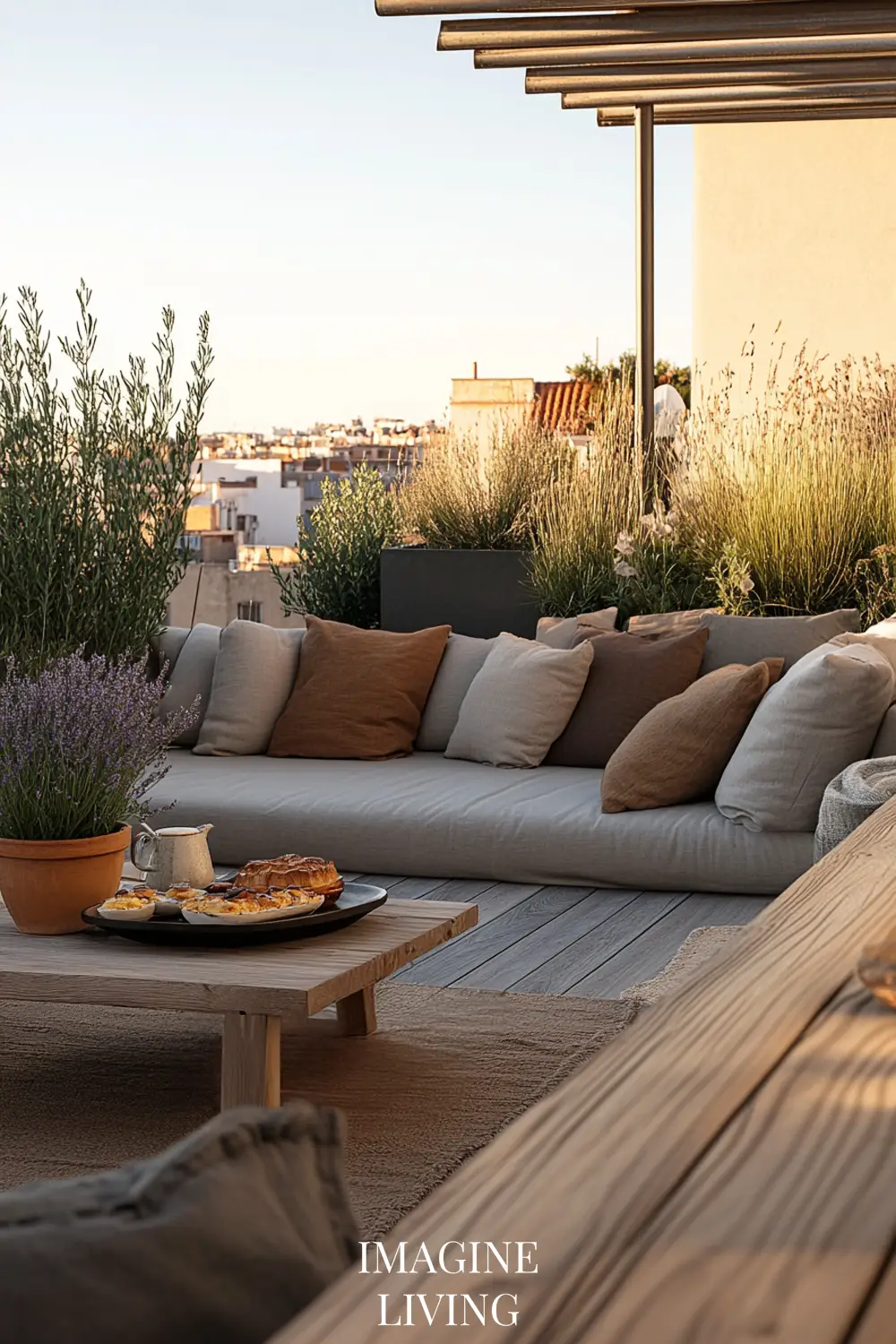
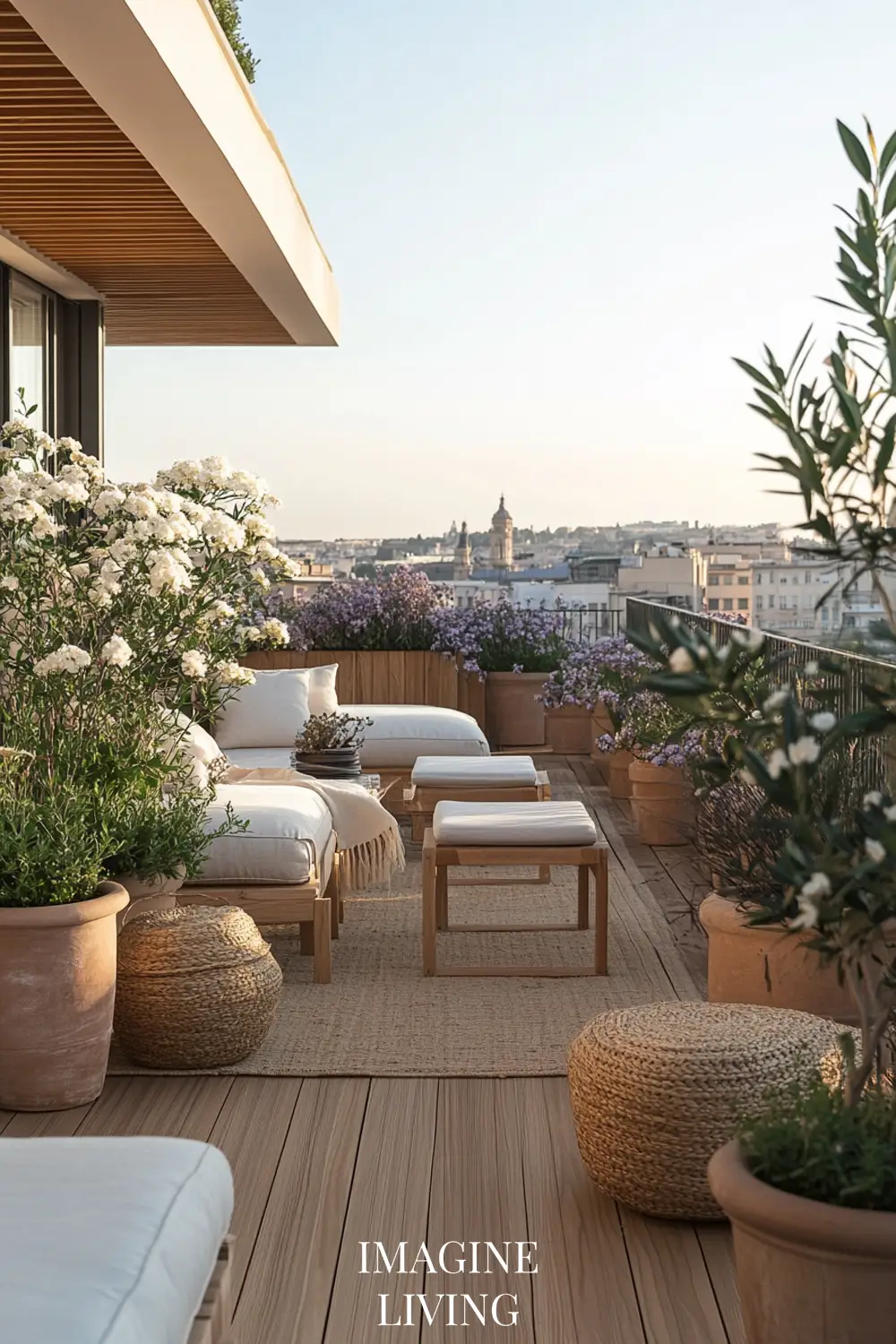
Architectural Touches:
Slatted privacy screens, concrete planters, built-in seating, or raised garden beds add a sense of form and permanence.
Outdoor Lighting with Design Value:
Slimline sconces, LED step lighting, orb-shaped floor lamps, or candle-filled lanterns. Light serves both function and form.
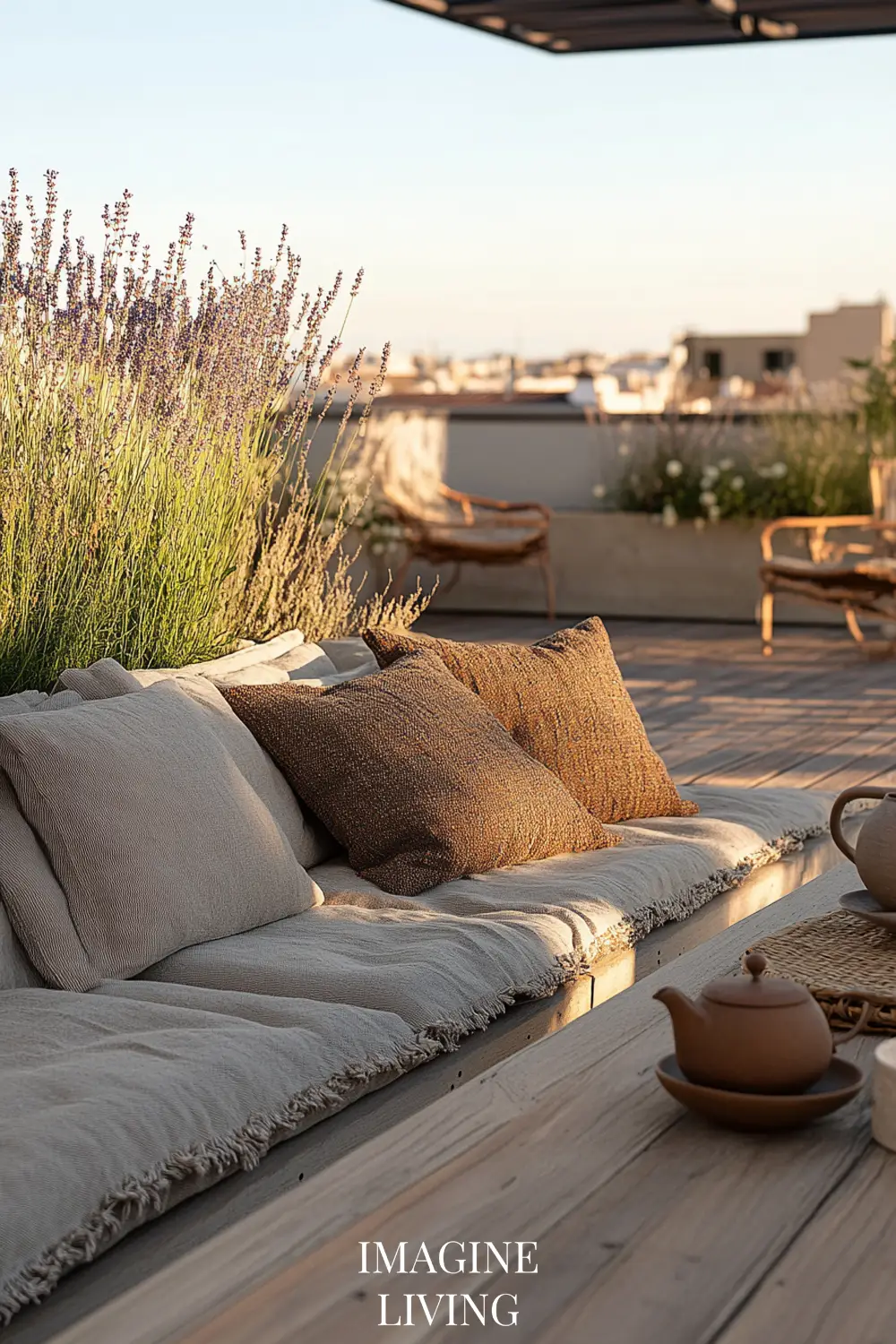

Textural Warmth:
Soft cushions, neutral poufs, and woven throws break up hard lines and make the space more inviting.

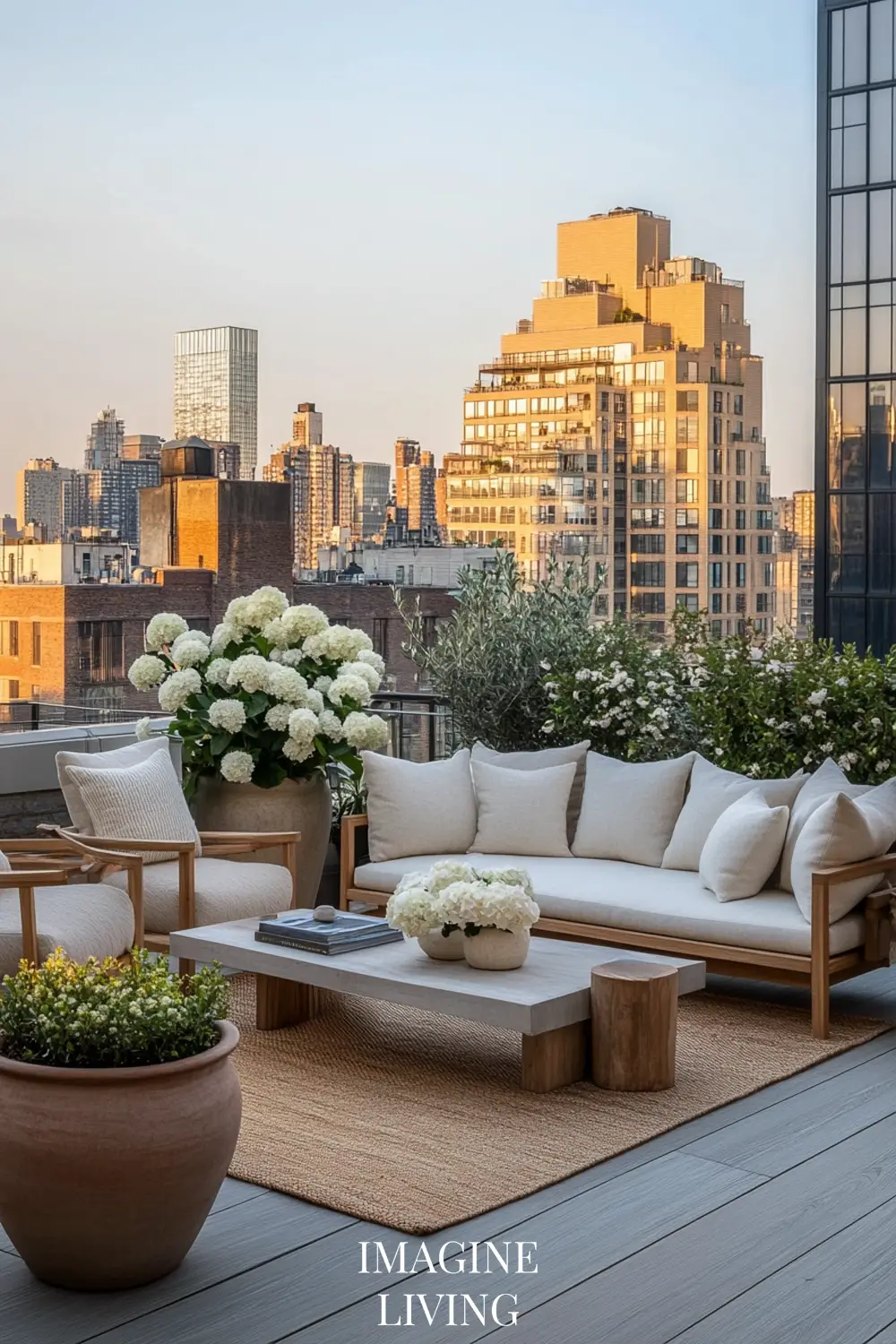
General Styling Tips for Modern Urban Terraces
Maximize Floor Space
Choose modular or space-saving furniture. Use nesting tables, bench seating, or collapsible chairs that keep the area open and adaptable.
Add Height with Greenery
Use tall plants or wall planters to draw the eye up. This helps make small spaces feel expansive and adds privacy from neighboring buildings.
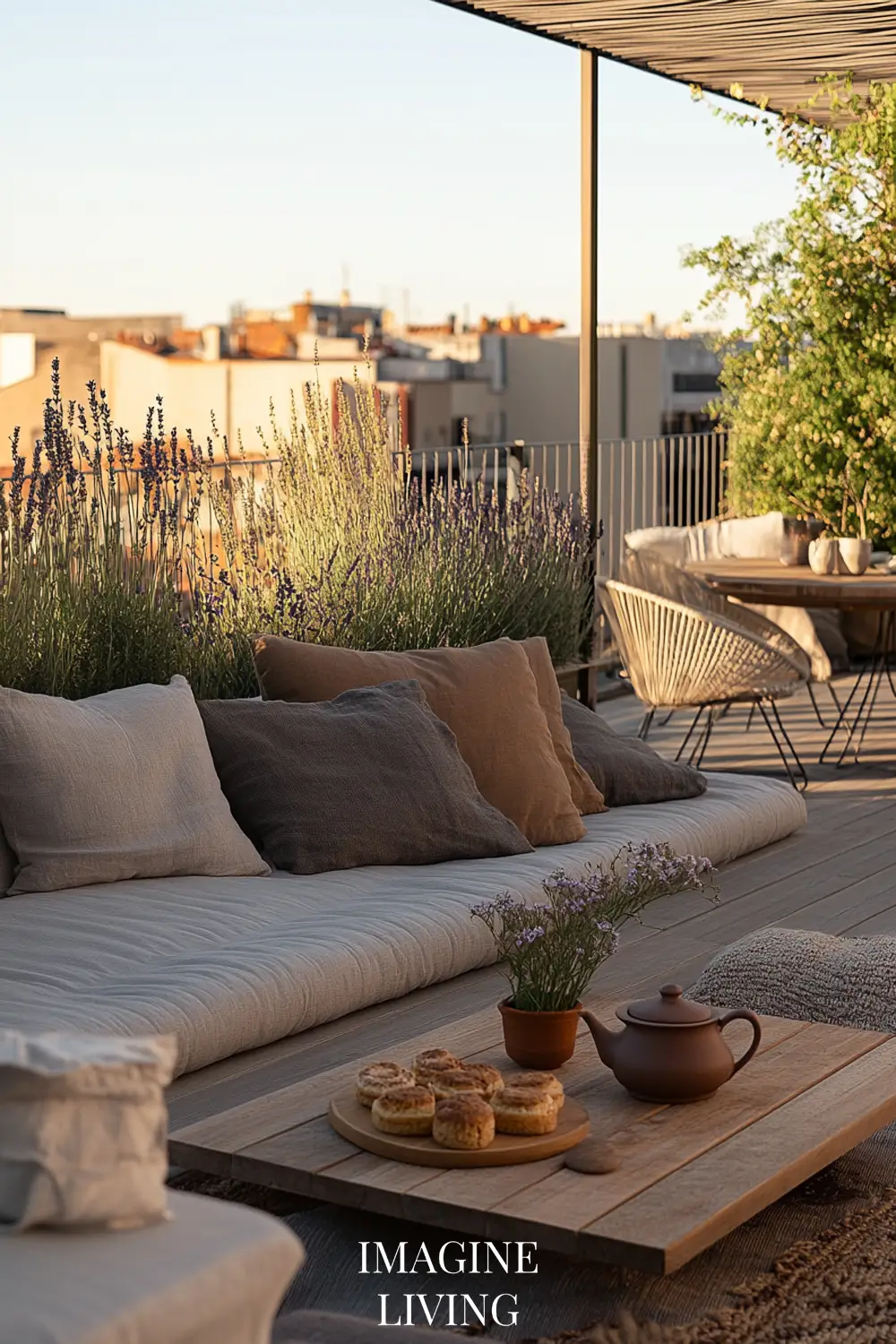
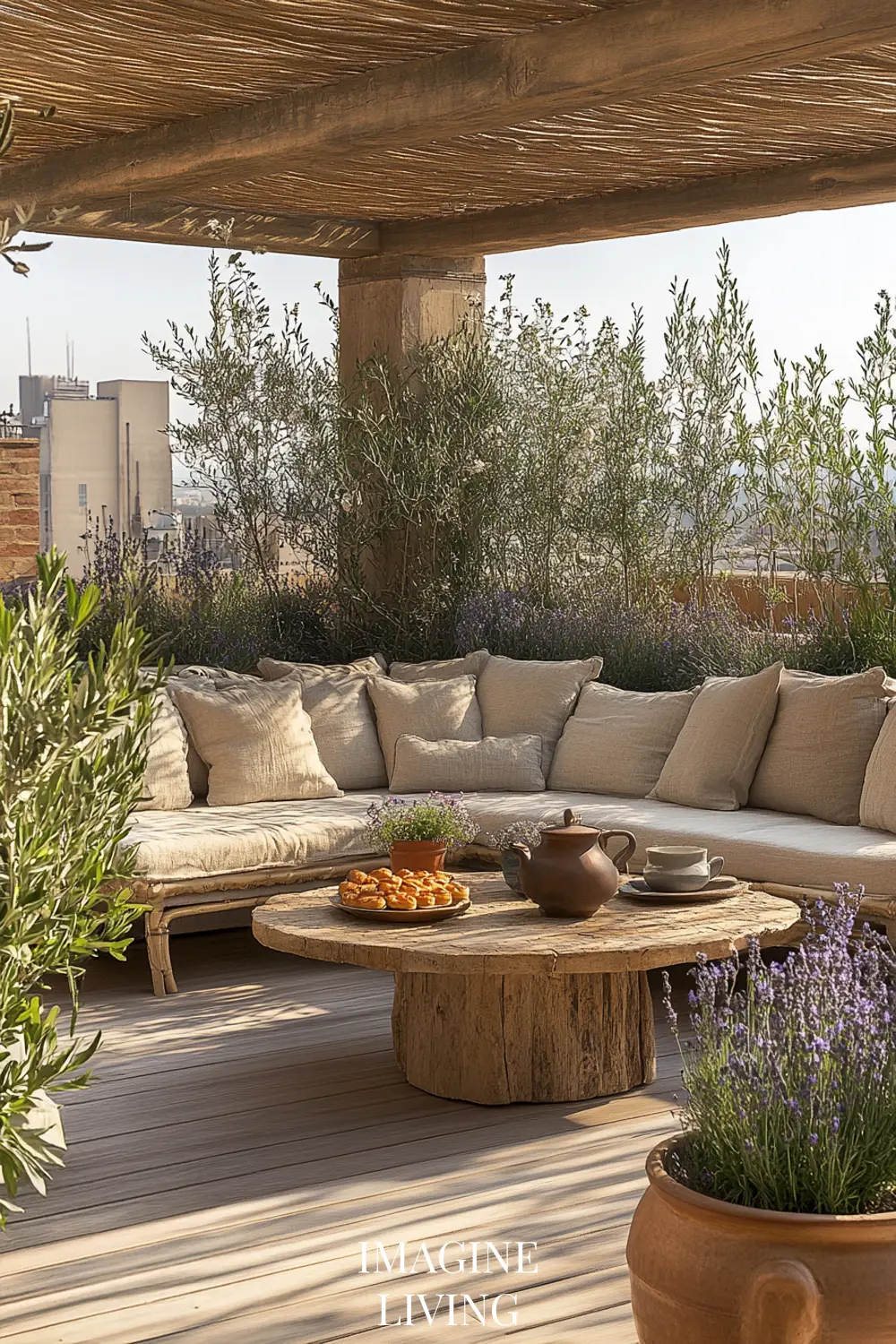
Layer with Purpose
Every piece should feel like it belongs. Limit accessories to a few high-impact items—a sculptural vase, a curated stack of books, a candle bowl.
Choose Durable, Natural Materials
Opt for outdoor-friendly yet natural finishes—wood, concrete, linen-blend fabrics—that age beautifully and withstand the elements.
Create Zoning Through Texture or Light
Use a rug to define the lounge area or lighting to highlight a corner nook. Zoning brings clarity to compact layouts.

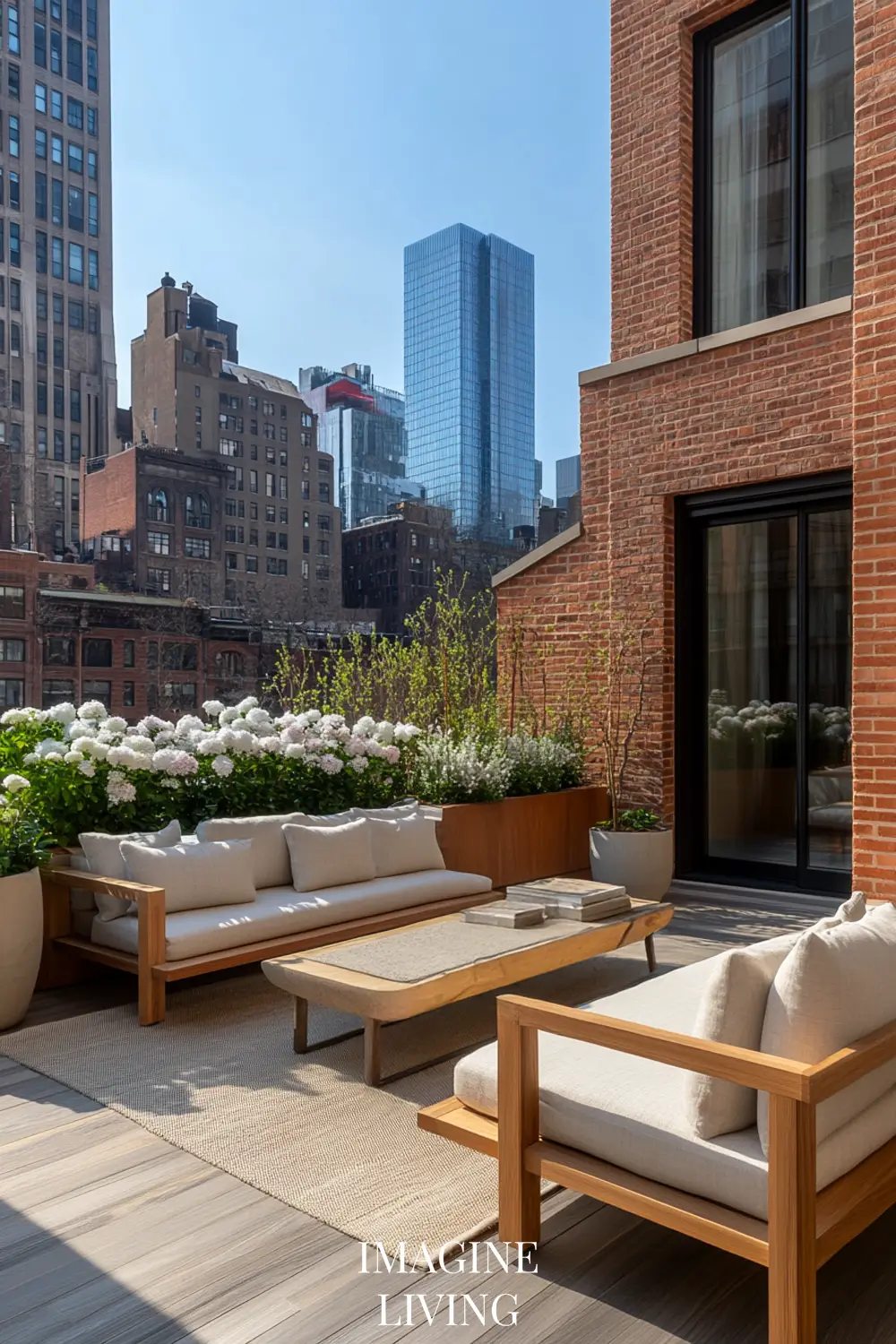
Mistakes to Avoid in Modern Urban Terrace Styling
Using Oversized Furniture
Avoid bulky pieces that overpower the space. Proportion is everything in an urban setting.
Ignoring Vertical Potential
Walls, railings, and vertical planters are prime real estate. Use them for greenery, lighting, or storage solutions.
Going Too Industrial Without Warmth
Balance hard materials with soft textures. Too much steel or concrete can make the space feel cold.
Skipping on Lighting
Don’t rely solely on overhead light. Use multiple small light sources to build atmosphere, especially for evening use.
Treating It Like an Afterthought
Design it like an interior space. A cohesive palette, layered texture, and intention will make it an extension of your home—not just a bonus square meter.
Small Balcony Ideas: Creating Beauty in Limited Space
A small balcony can feel like a hidden sanctuary in the heart of the city—intimate, sun-drenched, and lush with life. It doesn’t need to be grand or perfectly staged. The charm comes from thoughtful details, layered textures, and how the light moves through potted plants and natural fabrics.
In many ways, small balconies are the ultimate expression of slow living in an urban setting.
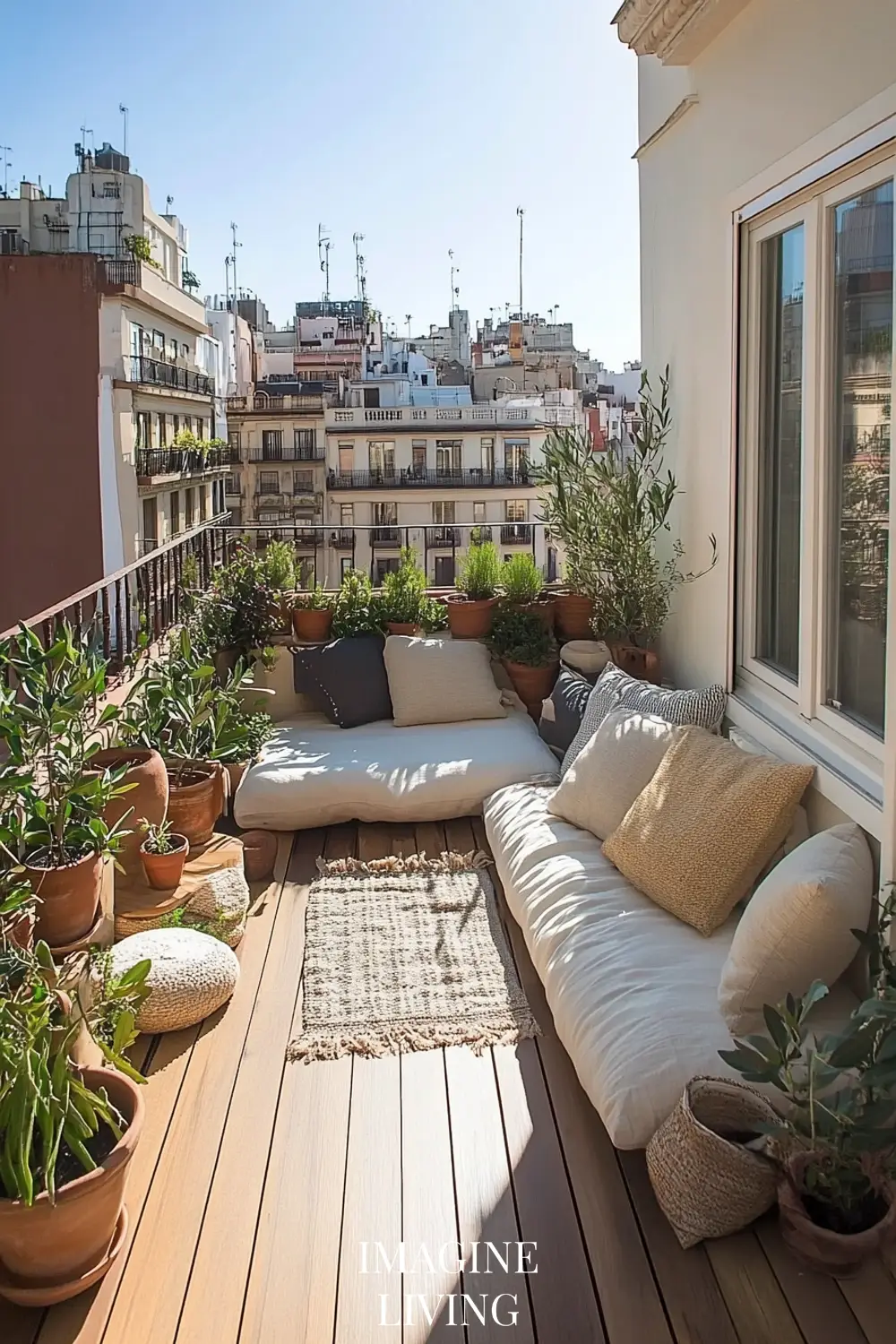
What Defines a Beautiful Small Balcony?
It’s all about purpose, calm, and atmosphere. These spaces often feel like a quiet morning with a linen throw, terracotta pots clustered near the railing, and a soft cushion tucked into a sunny nook. The best ones feel a little wild and personal—like a lived-in escape that’s been styled by intuition, not a catalog.
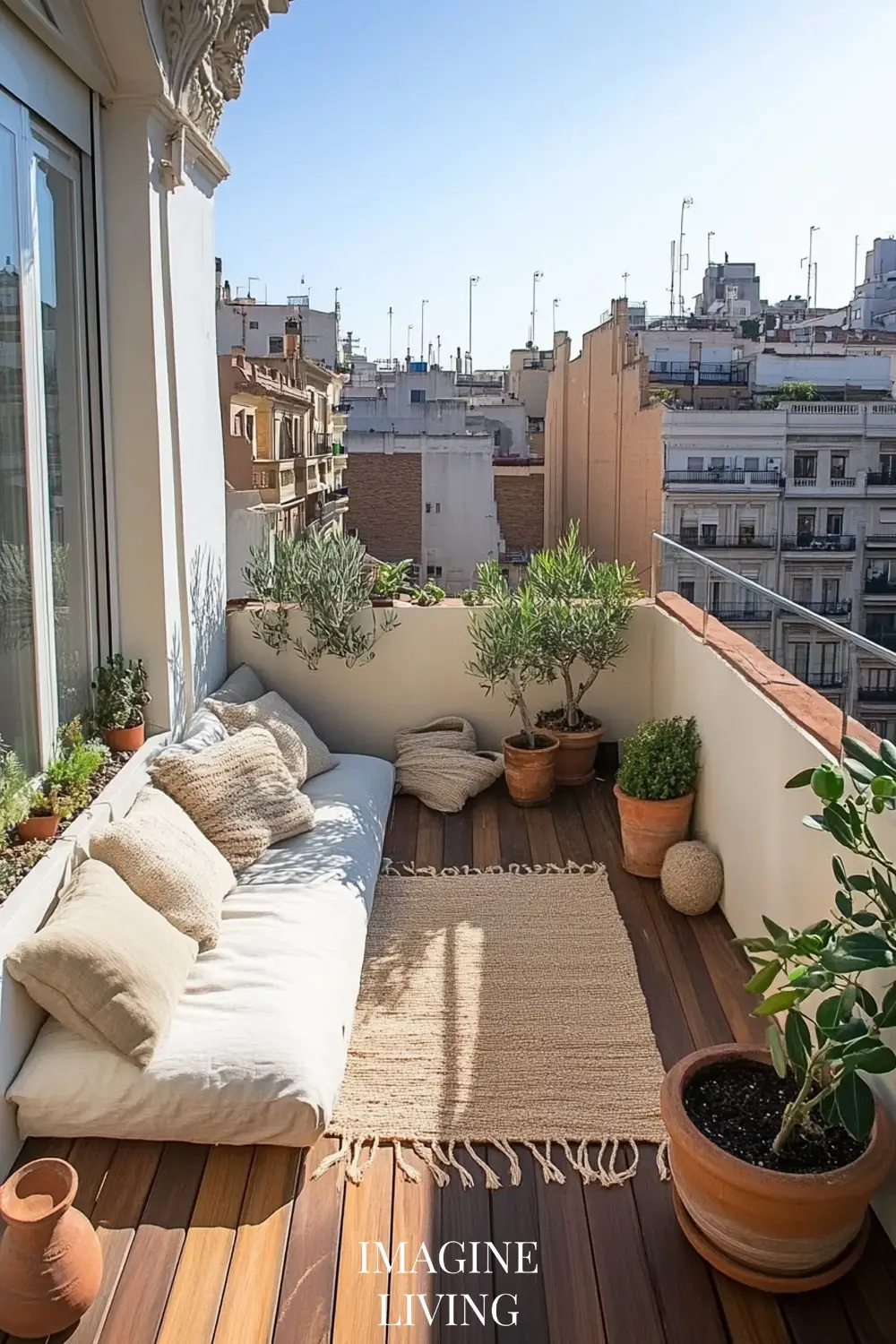
Key Styling Elements for Small Balconies
Low & Layered Seating:
Floor cushions, daybed pallets, or ultra-low sofas create a relaxed, grounded feel. Add loose linen or cotton throws in natural tones—ecru, sand, oat, ivory—and don’t be afraid to over-layer the cushions.
Woven Rugs & Textures:
Use soft, earthy jute rugs to define the space and bring in texture underfoot. Even if it’s a narrow balcony, one long runner rug in a woven style makes the area feel styled with intention.
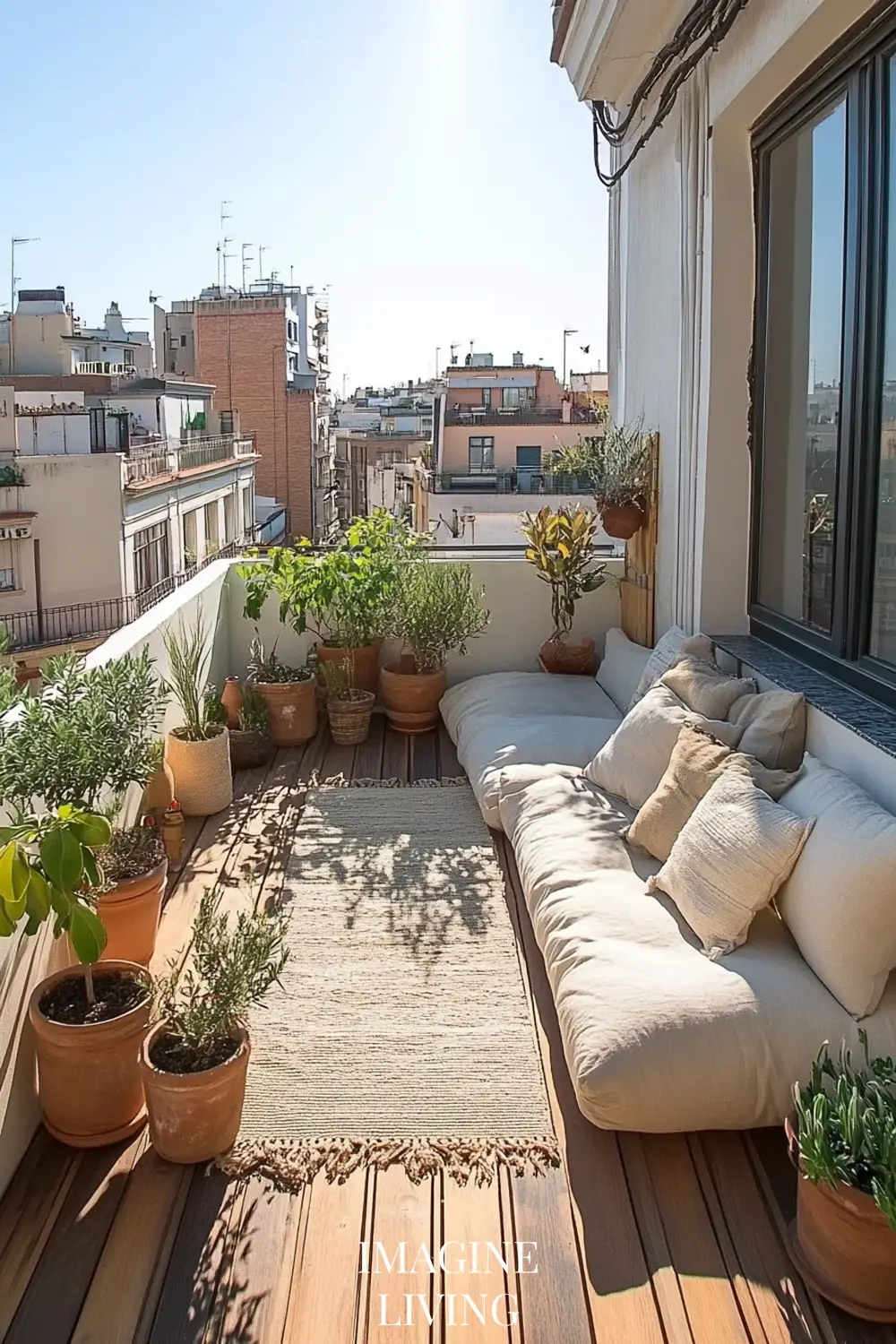
Clay & Terracotta Pots:
Skip plastic planters and go for rustic textures—aged terracotta, handmade ceramic, or stone. Group pots by height and let herbs, olive trees, or flowering greens peek above the railing.
Vertical & Corner Styling:
Use height smartly. Corners can become cozy nooks with a pillow stack and a hanging plant above. Or add a small wooden crate as a corner shelf for plants, candles, or a carafe of cold tea.
Natural Lighting Play:
Let sunlight fall where it may—small balconies look most beautiful in the golden hour. Add solar lanterns, candle jars, or fairy lights for cozy evening hangs.
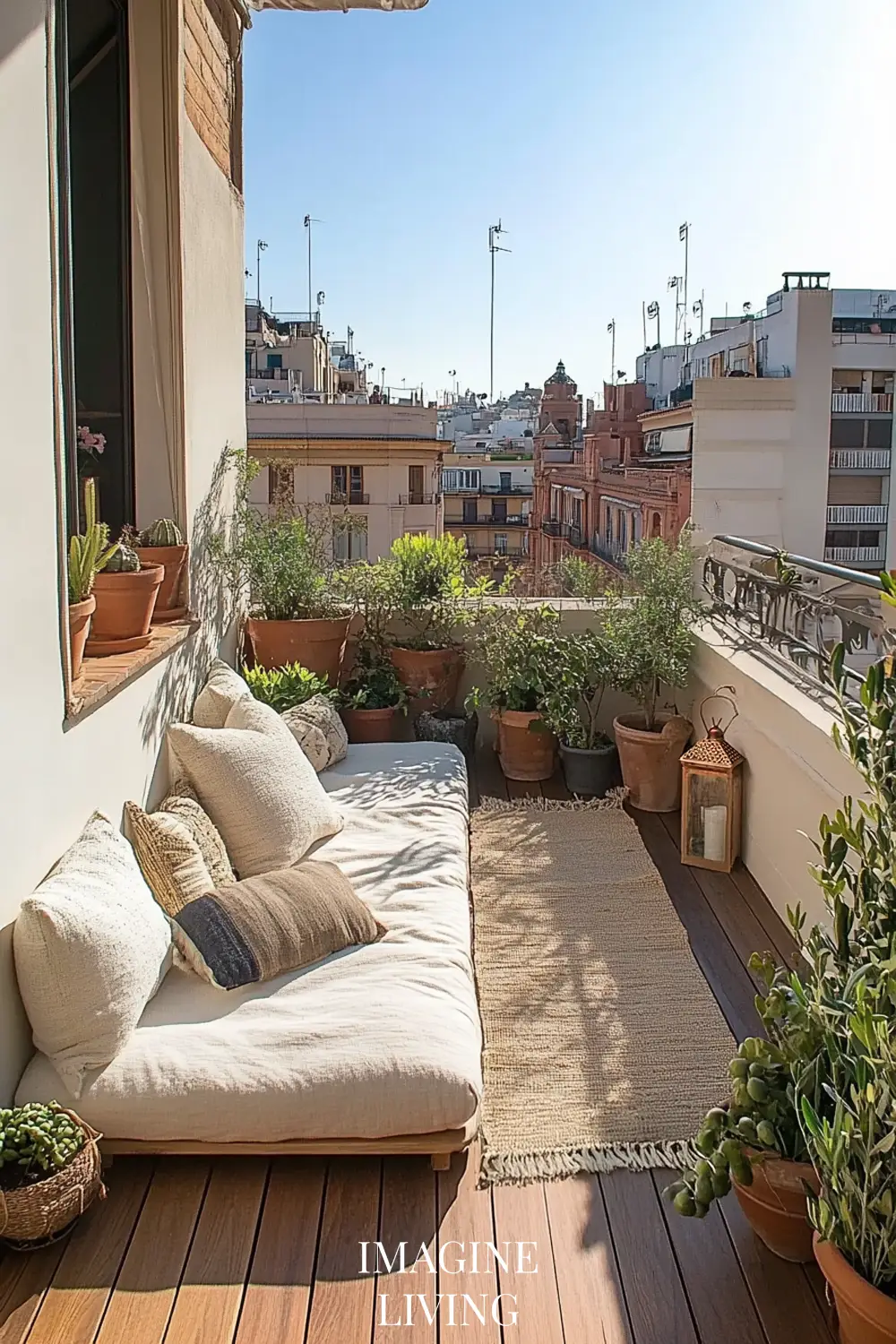
Tips for Styling a Small Balcony
Don’t Overcrowd.
Negative space matters more than ever in tight spaces. Choose a few key soft elements and give them room to breathe.
Use One Cohesive Color Palette.
Stick with warm neutrals and natural textures. A soft palette prevents visual noise and makes the area feel bigger and calmer.
Think Vertical for Greenery.
Stack planters, hang trailing greens, or install a simple trellis. It adds depth and screens off the city without blocking the light.
Keep Items Multipurpose.
A woven basket can store throws by day and become a table for snacks by evening. Use trays to easily move drinks and candles in and out.

Create a Ritual Space.
Whether it’s for morning coffee, reading, or evening chats—design around a ritual. One ceramic mug, one linen napkin, one potted herb—that’s enough to make it feel like home.
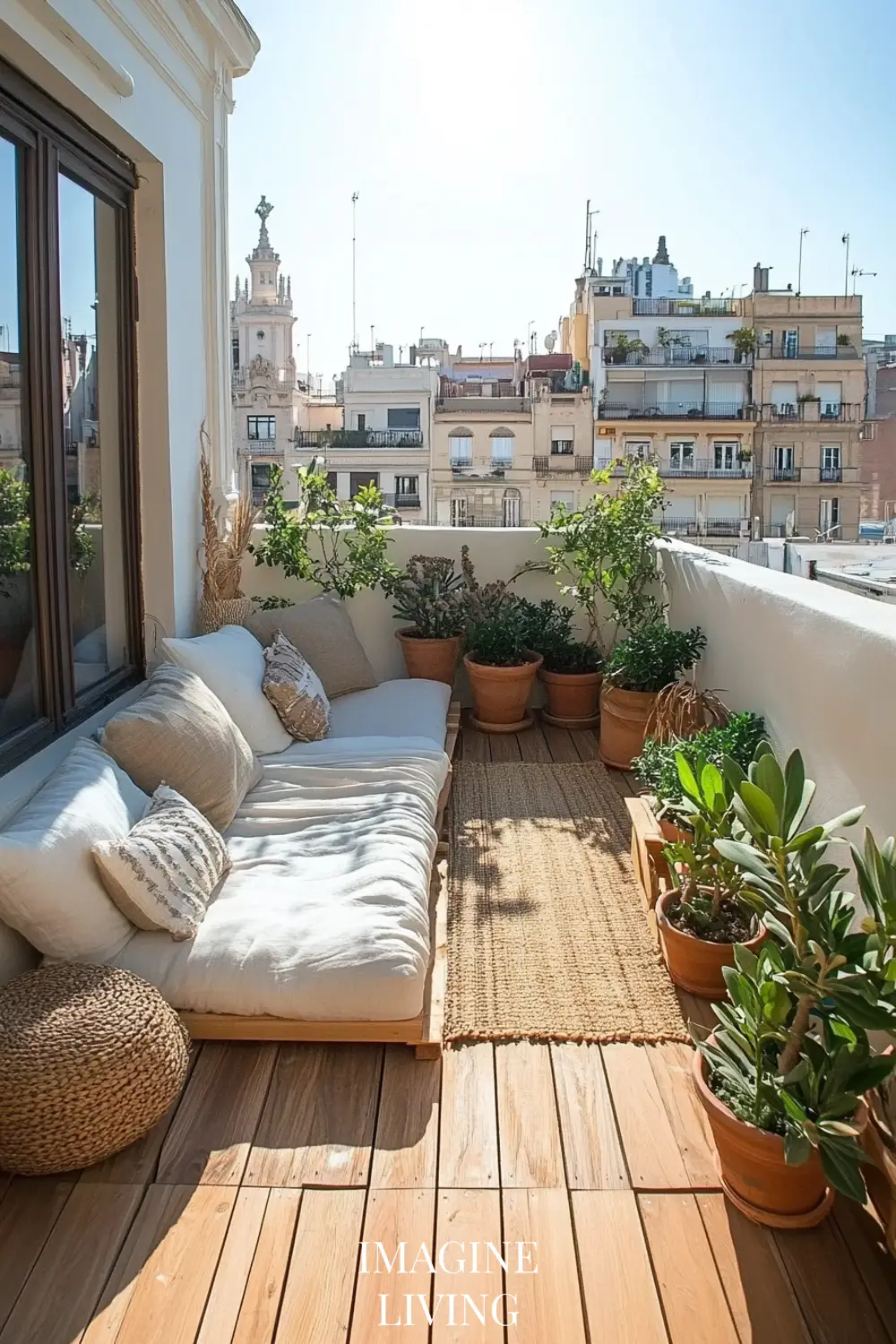
Mistakes to Avoid on a Small Balcony
Using Synthetic Textures.
Plastic outdoor rugs or shiny polyester pillows break the natural charm. Opt for cotton blends, jute, or outdoor-grade linen when possible.
Neglecting Lighting.
A single overhead bulb isn’t enough. Use layered lights—solar, battery, or real candlelight in hurricane jars—for instant softness.
Too Much Furniture.
Skip dining sets unless you have the space. One lounge cushion and a small tray table will do more for ambiance than a full setup.
Ignoring Scent.
Add herbs like rosemary or lavender near seating. Even a few sprigs in a jar can infuse the space with calming scent.
Forgetting Personal Touches.
A book, a linen towel, a favorite ceramic piece—it’s the human layer that makes a small balcony feel soulful, not staged.

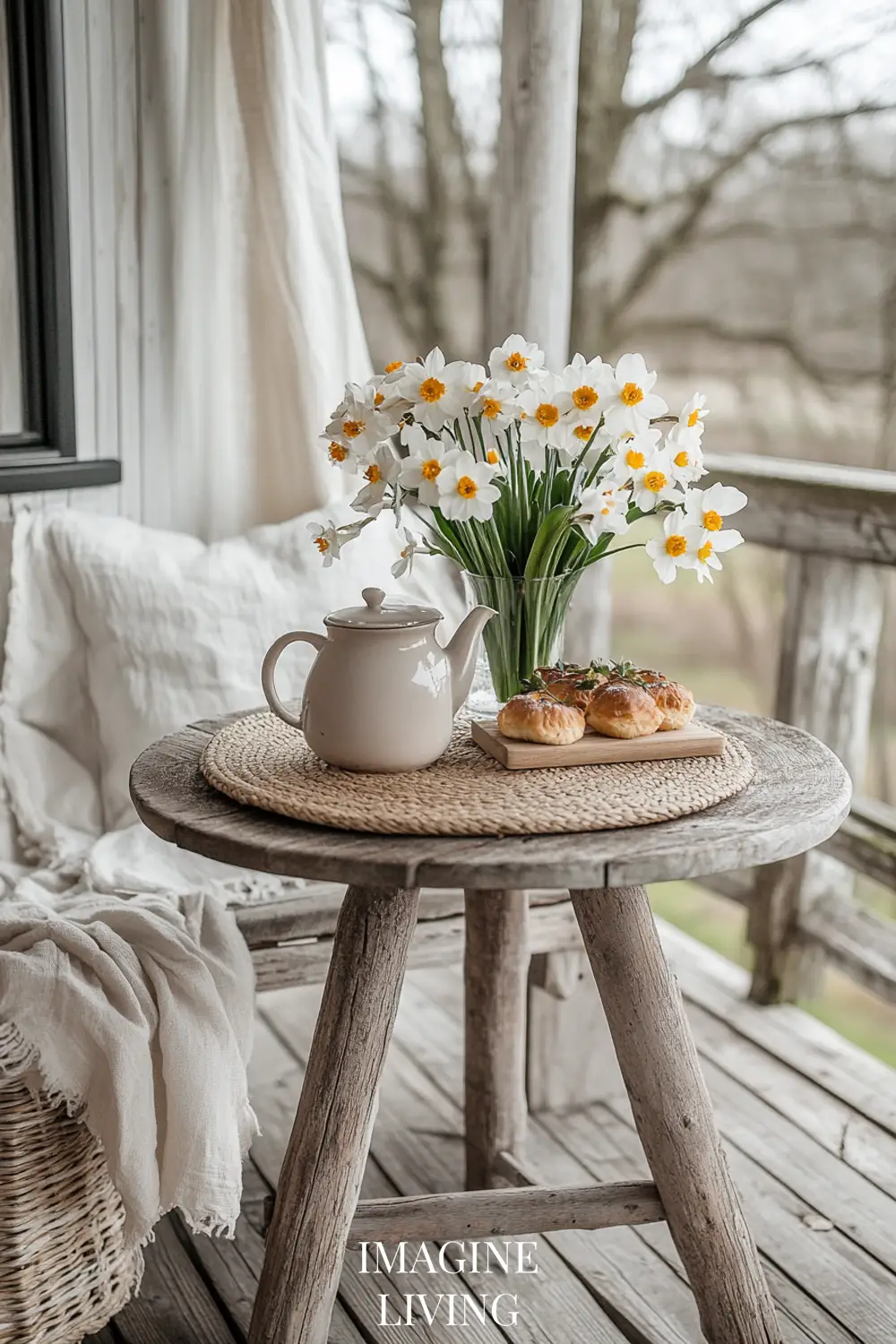
Cozy Cottage Porches: Wild, Warm, and Inviting
These porches whisper nostalgia. Overflowing pots of chamomile and daisies, rustic furniture with worn patina, and pillows that look plumped by hand.
Look for:
- Weathered wood benches and small café tables
- Vintage-style ceramic jugs filled with wildflowers
- Wicker baskets as plant holders or for throws
- Warm off-whites, oatmeal, and buttery beige
Design tip: Keep it asymmetrical. Cottage styling thrives on imperfection—let your planters vary in size and finish, and layer cushions casually.
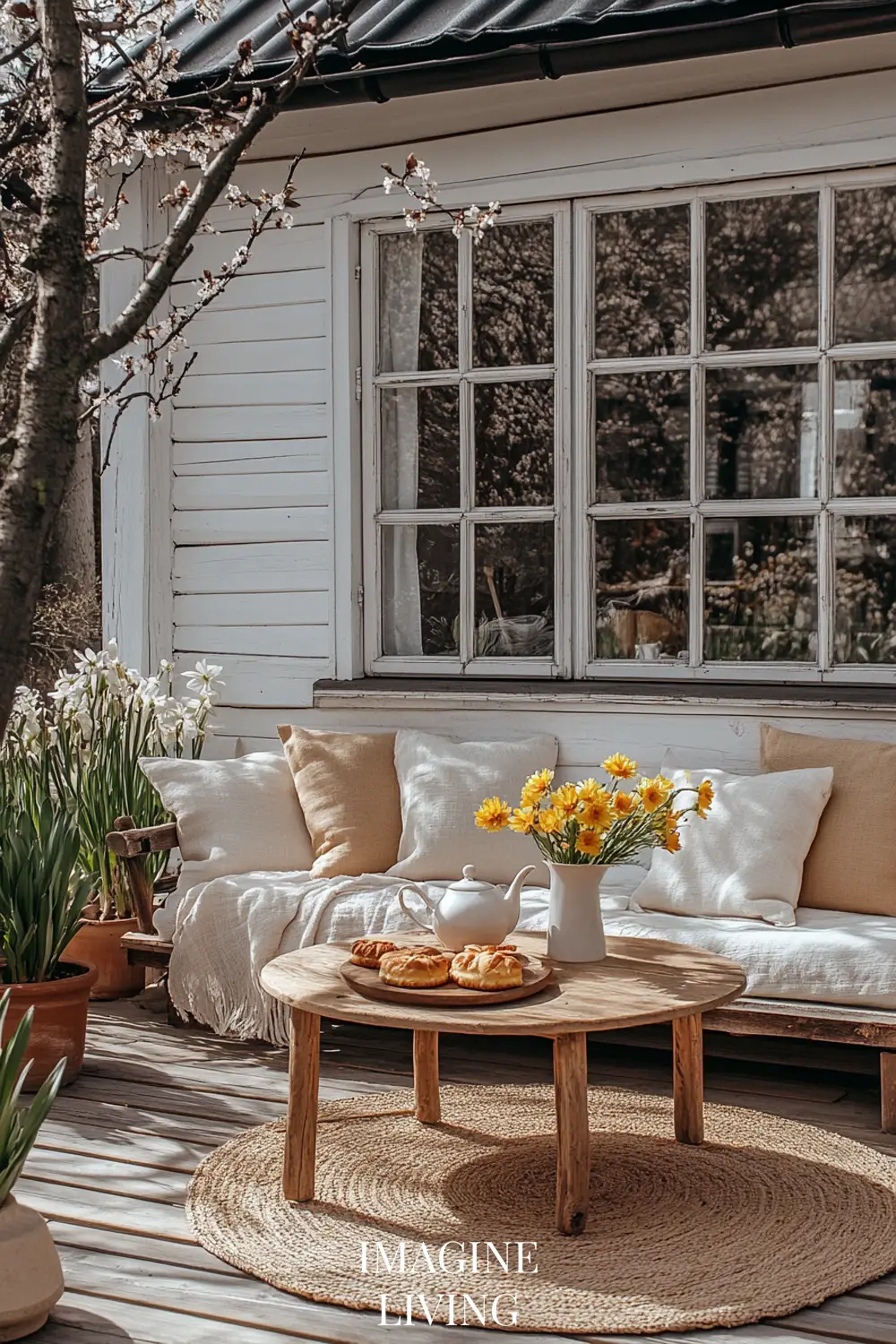

What Defines a Cozy Cottage Porch?
A cozy cottage porch feels like a warm embrace. It’s where sunlight filters through climbing vines, a teacup rests on a vintage stool, and time seems to slow down. Unlike more structured styles, cottage porches thrive on personality—layered textiles, chipped paint, hand-thrown ceramics, and whatever blooms were gathered from the nearby field or garden.
What makes them so beloved is the lived-in charm. Nothing feels staged, yet every item holds meaning. These porches aren’t curated for perfection—they’re spaces for storytelling, memory, and quiet joy.

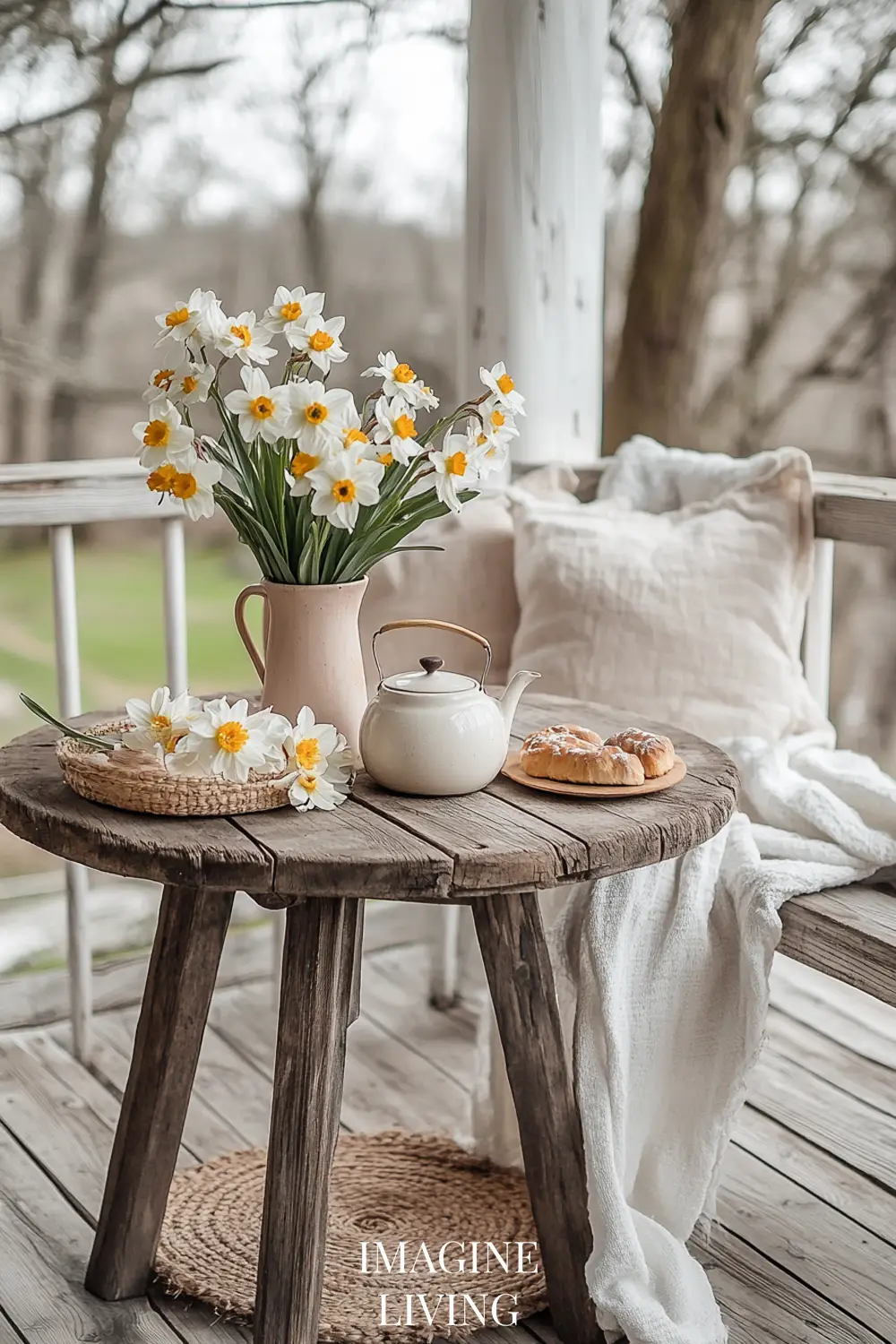
Key Elements of a Cozy Cottage Porch
Weathered Wood and Vintage Pieces:
Old benches, wicker chairs with age-softened frames, or a painted side table with worn corners. These pieces tell their own stories.
Lush, Overgrown Florals:
Wildflowers in enamel jugs, daisies spilling from baskets, lavender pots by the steps—nature is everywhere, never over-pruned.
Textiles with Heart:
Patchwork throws, embroidered cushions, gingham, or soft florals. Fabrics are layered, cozy, and intentionally mismatched.
Pastel and Earthy Palette:
Soft sage, blush pink, creamy white, cornflower blue, and warm beige. The hues feel like they’ve been faded by years of sun and rain.

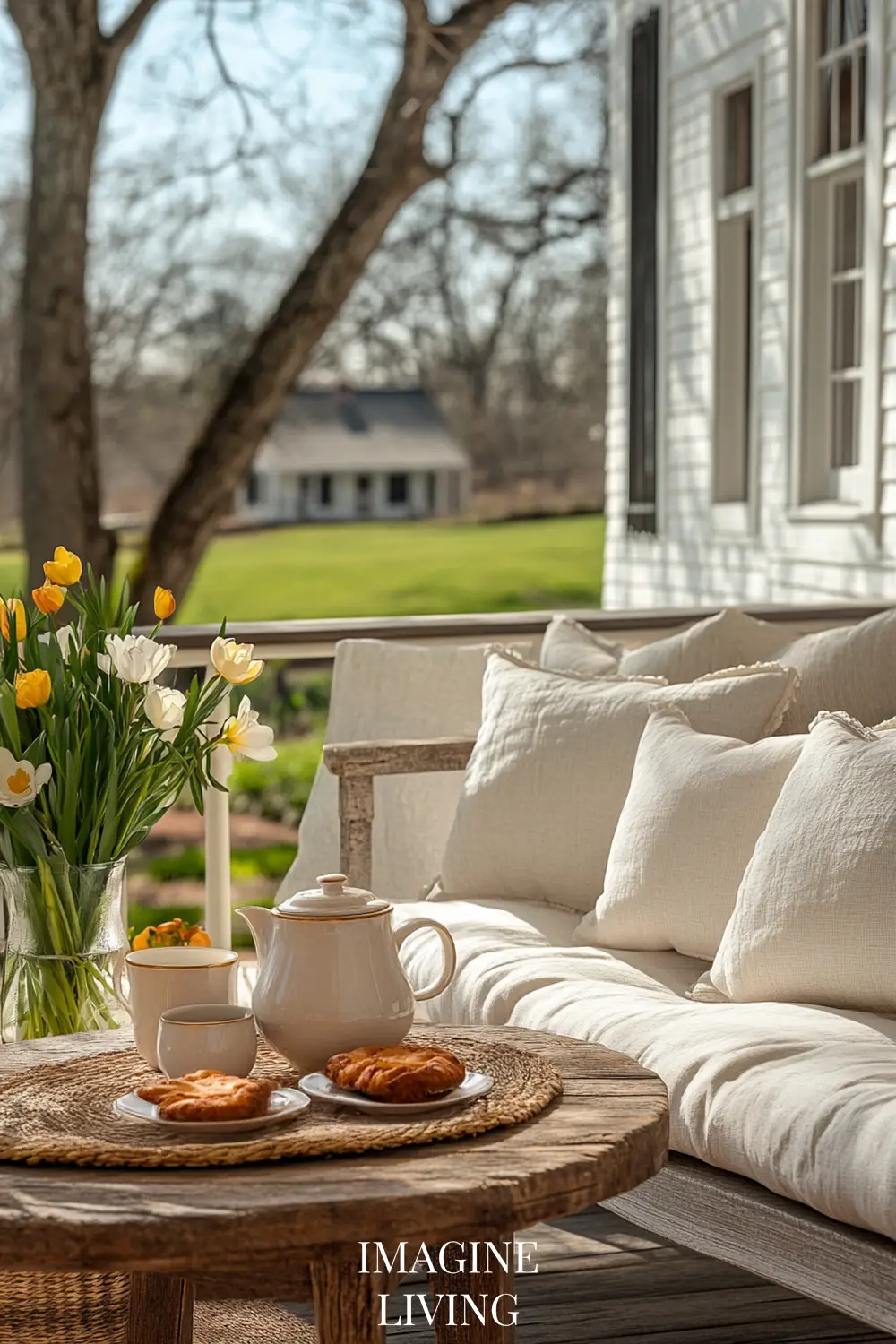
Charming Clutter:
Books on benches, a straw hat on a hook, mismatched mugs—there’s an organic layering of everyday life that feels heartwarming, not messy.
Soft Lighting or None at All:
Candle lanterns, a low-hanging bulb, or natural sunlight through leafy branches. It’s about warmth, not brightness.
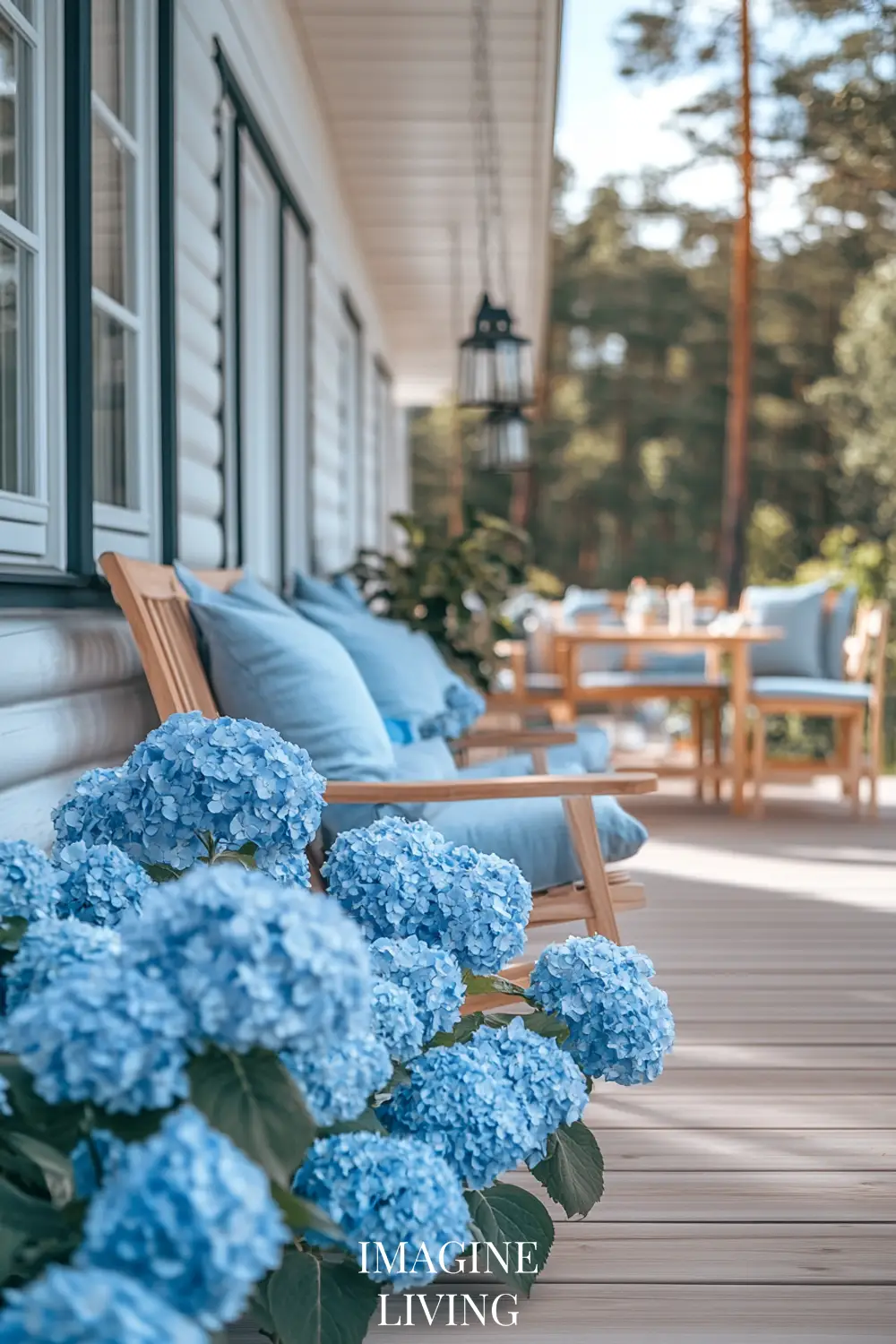
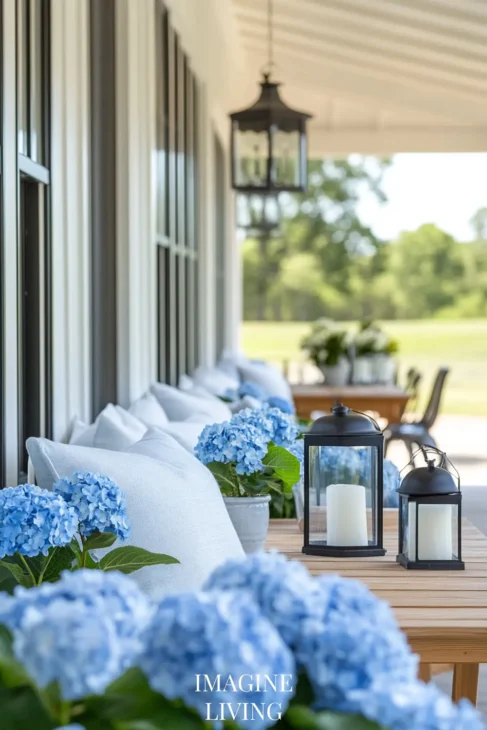

General Styling Tips for Cozy Cottage Porches
Mix and Layer Without Fear
Let textures collide—cotton, linen, wool, rattan. Combine vintage with handmade. This is the one style where more can be more, as long as it’s heartfelt.
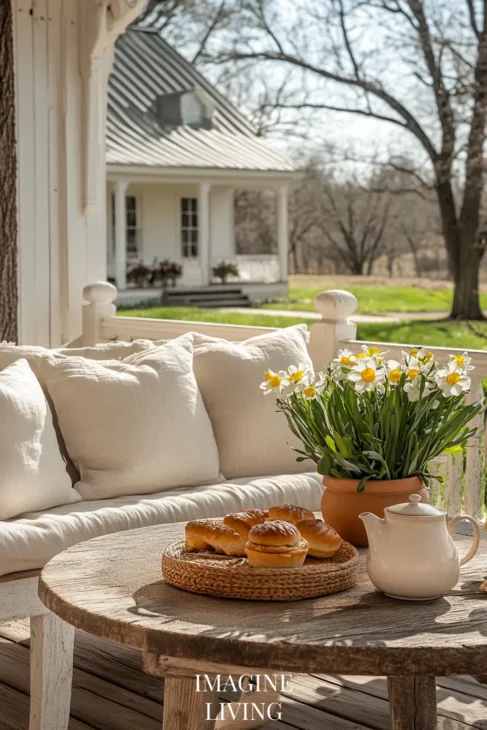

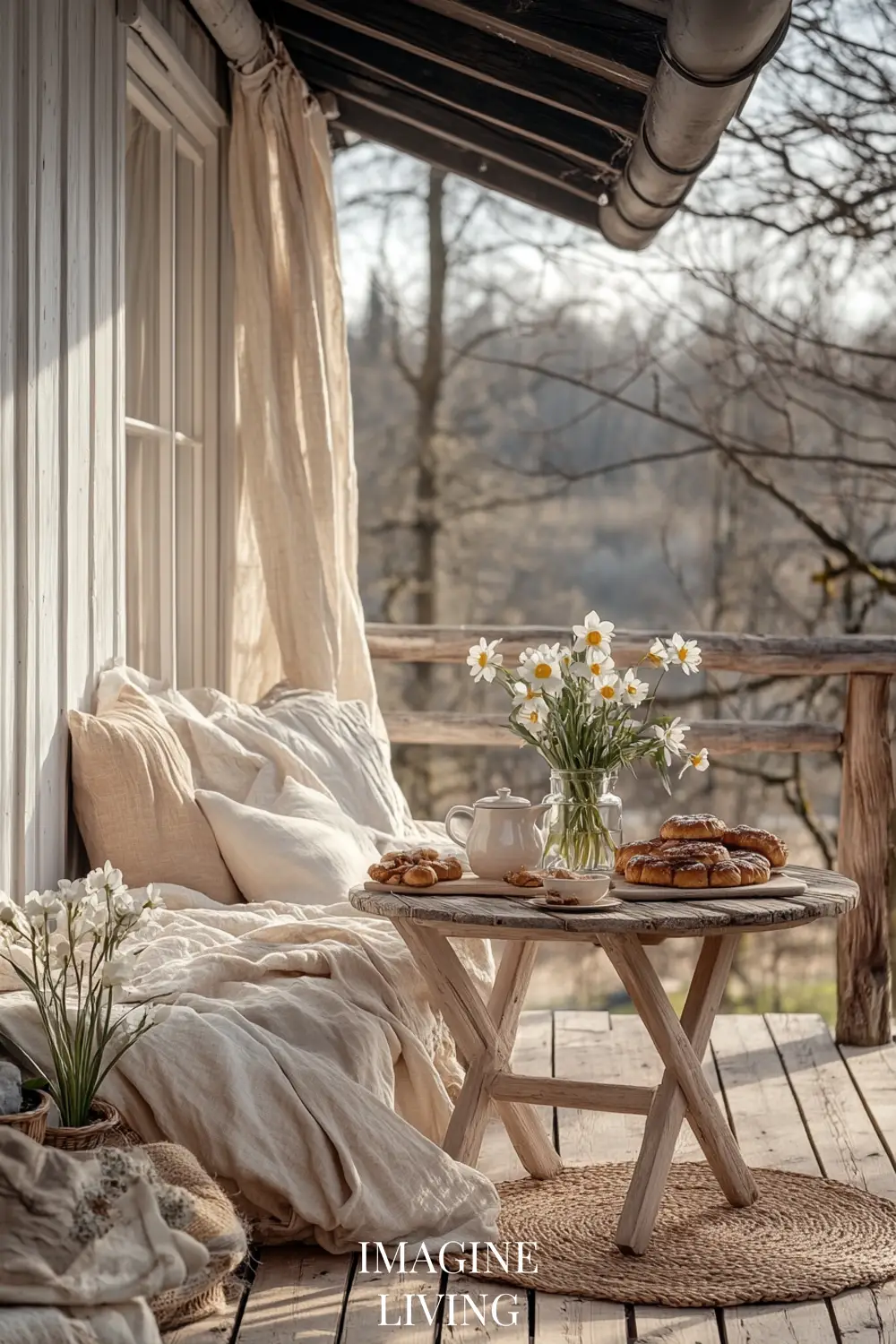
Embrace Imperfection
A little rust on the lantern or chips on the terracotta pot? Perfect. Let patina, wear, and character shine.
Use Everyday Items as Decor
That teacup, basket of twine, or worn watering can adds soul. Cottage porches celebrate domestic life.

Create Intimate Nooks
Layer throws and pillows on a bench or nook to create a reading corner or a morning tea spot.
Let Nature Spill In
Let vines creep, herbs flower, and branches lean into the porch space. Cottage charm thrives on a bit of beautiful wildness.
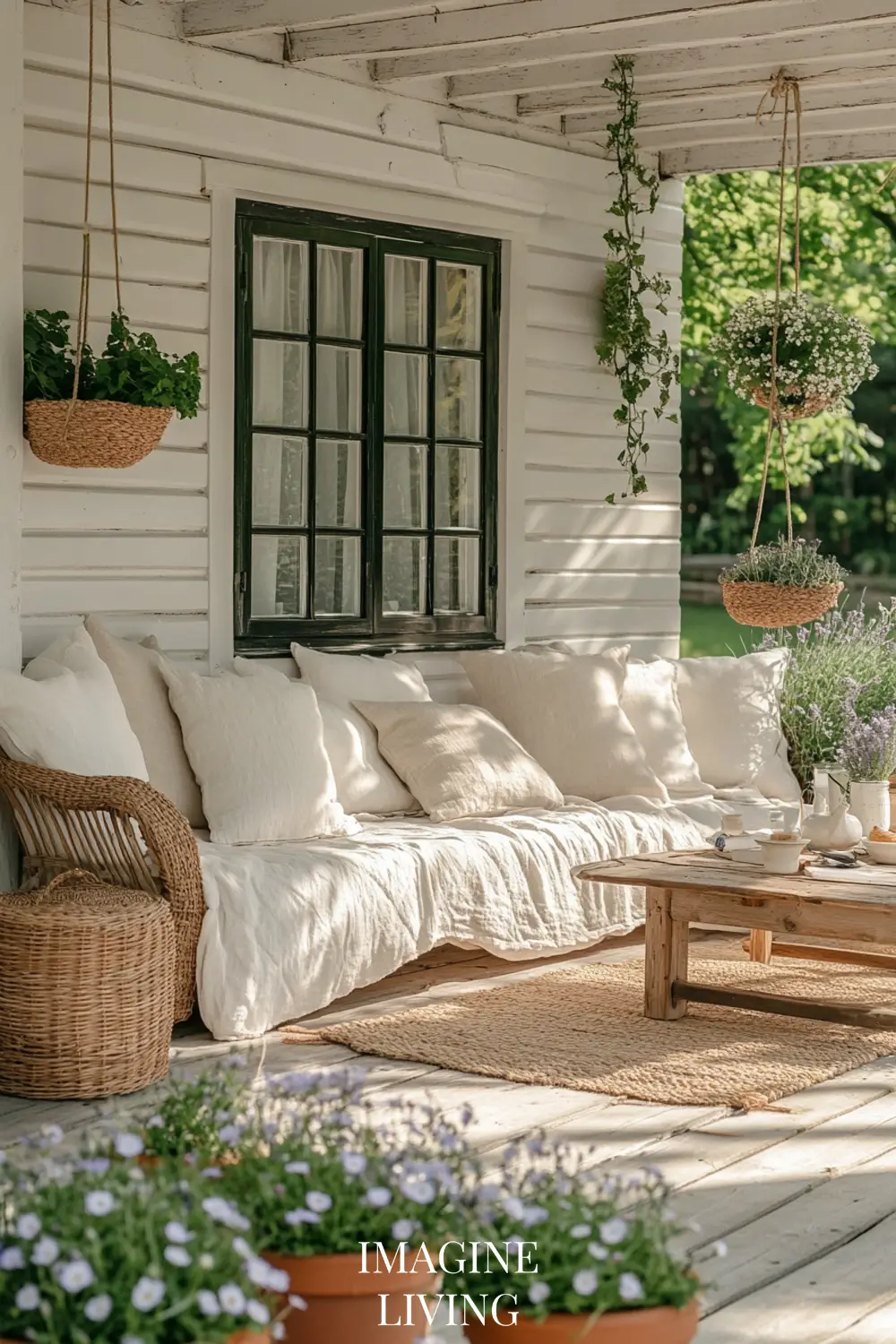


Mistakes to Avoid in Cozy Cottage Porch Styling
Making It Too Perfect or Coordinated
Uniform decor kills the cottage mood. It should look collected over time, not bought in one go.
Overusing Synthetic Materials
Plastic furniture or glossy finishes break the spell. Natural or vintage materials make the space feel real and inviting.
Leaving It Too Bare
Cottage porches are sensory and full of life. A bench and two chairs aren’t enough—layer in texture, plant life, and personal touches.
Over-theming or Over-branding
Skip signs that say “farmhouse” or “porch rules.” The space itself should tell the story without cliché props.
Forgetting Functionality
Even a charming porch needs practical flow. Make sure there’s room to move, to sit comfortably, and to enjoy the space you’ve created.
Coastal and Seaside Decks: Calm Breezes & Sunbleached Style
Beachside styling leans into lightness. Wide-planked wood, sun-faded tones, and the simplicity of driftwood and sea grass. It’s an effortlessly lived-in look.
Look for:
- Whitewashed or natural wood furniture
- Neutral outdoor textiles that can withstand the elements
- Sea glass, woven lanterns, and textured vases
- Large pillows and poufs for floor lounging
Design tip: Keep the horizon in mind—everything should feel low, light, and close to the earth.
What Defines a Coastal Porch?
A coastal porch captures the spirit of salt in the air, bare feet on warm wood, and an uninterrupted breeze that moves through every corner. It’s breezy, weightless, and grounded in simplicity. The space doesn’t try too hard—it simply exists in harmony with the sea and the sky.
Coastal porches are about ease, not excess. Think wide plank floors, gauzy textiles, driftwood textures, and a palette borrowed directly from sand, shells, and seagrass. It’s the kind of place where time feels suspended, where light is everything, and the sound of the wind becomes part of the decor.
Key Elements of a Coastal Porch
Whitewashed or Driftwood Tones:
Furniture and floors in weathered wood, light oak, or painted white finishes that reflect sunlight and stay cool.
Low, Lounge-Style Seating:
Daybeds, floor cushions, deep armchairs, or bench seating softened with overstuffed linen or cotton pillows.
Sheer Textiles & Movement:
Billowy curtains, lightweight throws, and upholstery that flows with the breeze. Nothing stiff or heavy—just softness in motion.
Natural Neutrals with Sea-Inspired Hues:
Sand, shell, salt, stone, and the palest sky blue. These tones create a barely-there palette that soothes the eye and calms the mood.
Airy Decor with Organic Shapes:
Glass vases with pebbles, sculptural bowls, woven lanterns, sea grass baskets. Everything feels as if it was found—not purchased.
Connection to Nature:
The porch often opens directly to the garden, dunes, or a coastal view. It’s never fully enclosed—openness is the whole point.
General Styling Tips for Coastal Porches
Keep It Light and Low
Avoid bulky or dark furniture. Keep everything low to the ground, airy, and close to nature. The horizon should be uninterrupted.
Let the Breeze Style the Space
Use sheer linen or gauze curtains that dance in the wind. Textiles should feel sun-washed and soft, not structured or stiff.
Use Materials That Age Beautifully
Teak, rattan, raw ceramics, jute, and stone all develop character with exposure. Let the environment shape the look over time.
Design for Barefoot Living
Layer soft rugs, floor cushions, or woven mats underfoot. Coastal porches are meant to be felt with your whole body—not just looked at.
Limit Accessories to the Essentials
A single statement vase, a well-worn lantern, or a scattering of candles goes a long way. Space and air are your greatest design tools here.
Mistakes to Avoid in Coastal Porch Styling
Going Full Nautical Theme
Skip the ropes, anchors, and navy-blue everything. Coastal design isn’t about kitsch—it’s about calm.
Using Synthetic or Glossy Materials
Plastic chairs or shiny metals feel out of place. Choose natural finishes with matte textures.
Over-Stuffing the Space
Resist the urge to fill every corner. Coastal porches need negative space for light and movement.
Overprotecting Everything
Let materials breathe. You don’t need everything to be “weather-proofed”—imperfection is part of the look.
Using Cool or Harsh Lighting
Stick with warm, soft glows: woven pendant lights, solar lanterns, or clusters of tea lights. Think moonlight, not spotlight.
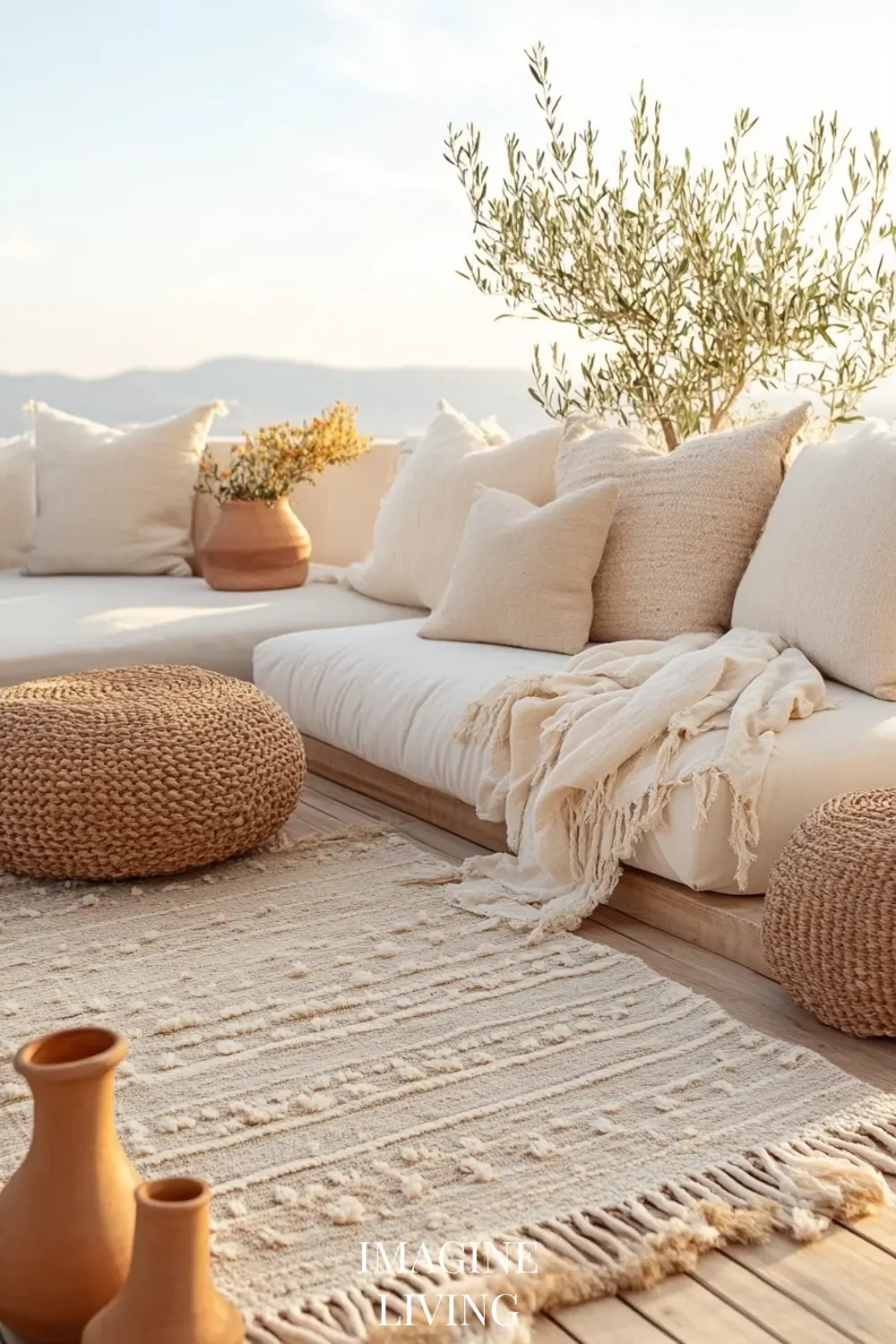
Warm Mediterranean Touches: Earthy and Layered
Inspired by Greek patios and Spanish courtyards, this look combines terracotta, carved wood, and sun-baked colors with cozy intimacy.
Look for:
- Terracotta pots grouped in threes or fives
- Wooden coffee tables with carved or aged detail
- Olive trees or fig in planters
- Woven poufs and chunky textiles
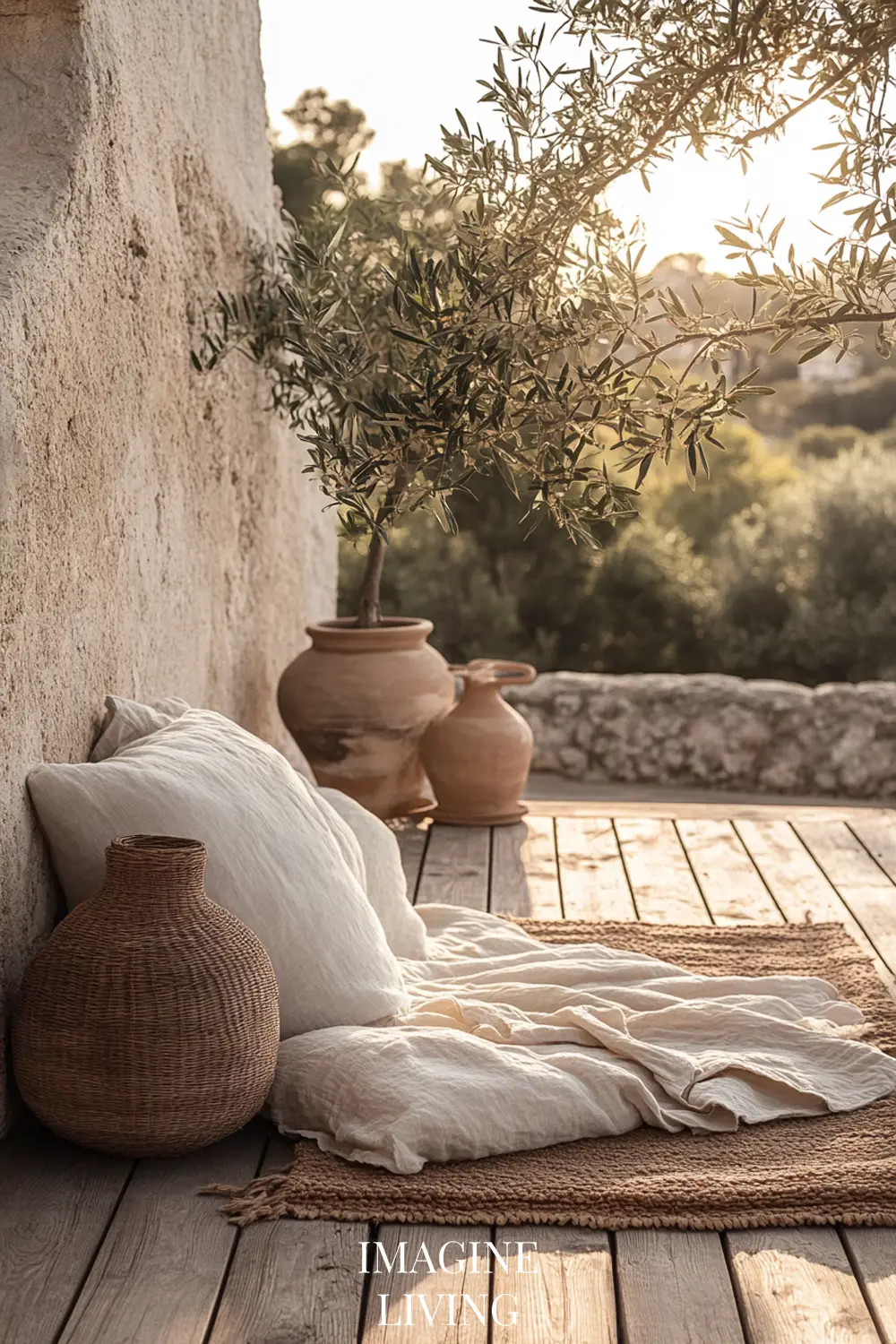
Design tip: Add just one bold ceramic or tile detail to nod to tradition without overwhelming.
What Defines a Warm Mediterranean Porch?
A warm Mediterranean porch feels sunbaked and soul-rich—an open-air space where terracotta breathes, shadows shift through arches, and olive branches sway in the golden breeze. Rooted in southern European tradition, this style evokes both rustic grounding and effortless elegance.
It’s not about perfection—it’s about patina. Surfaces are textured, materials feel ancient and natural, and everything—from the iron lantern to the curved bench—feels like it belongs under the sun. It’s earthy, warm, and unapologetically sensual.
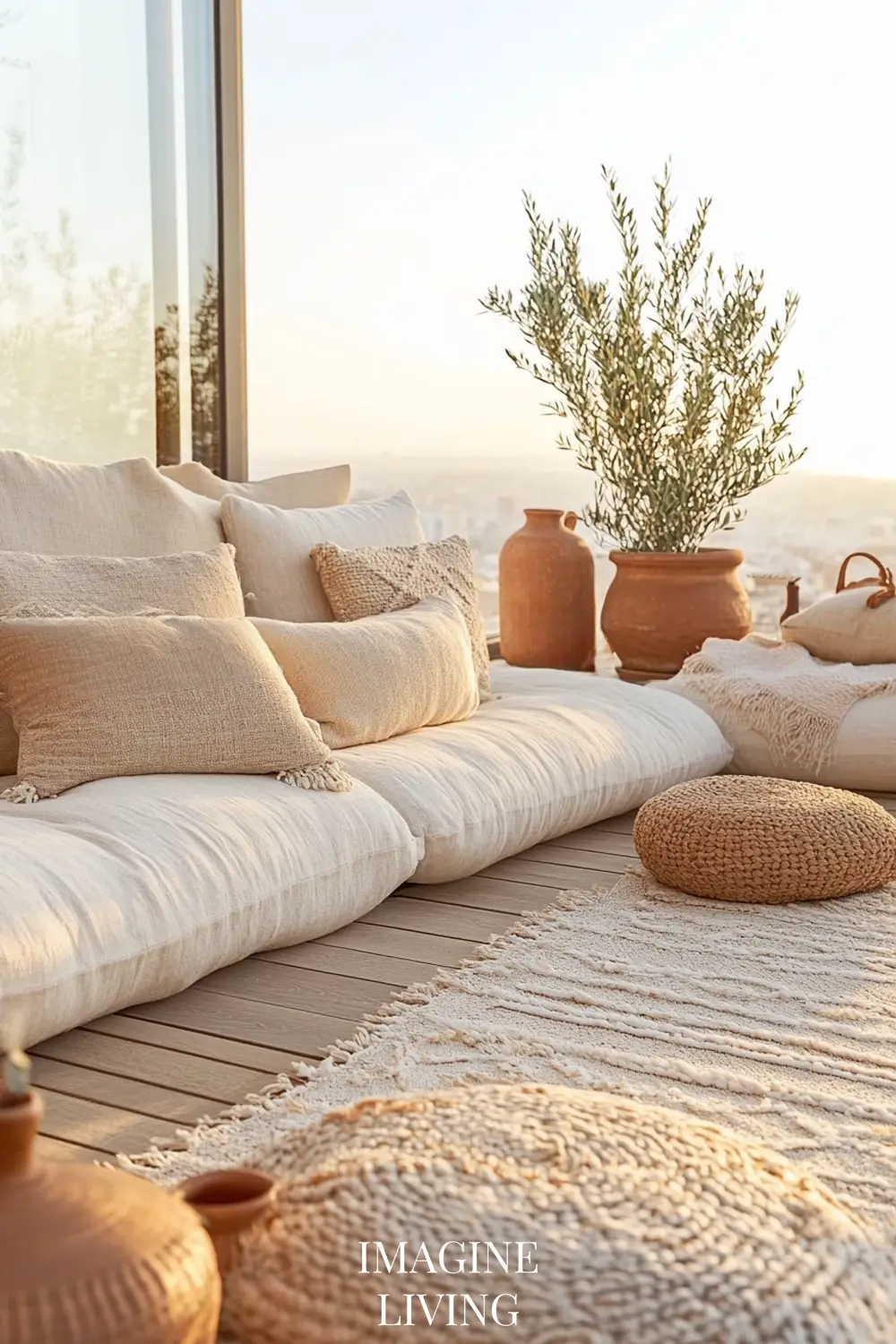
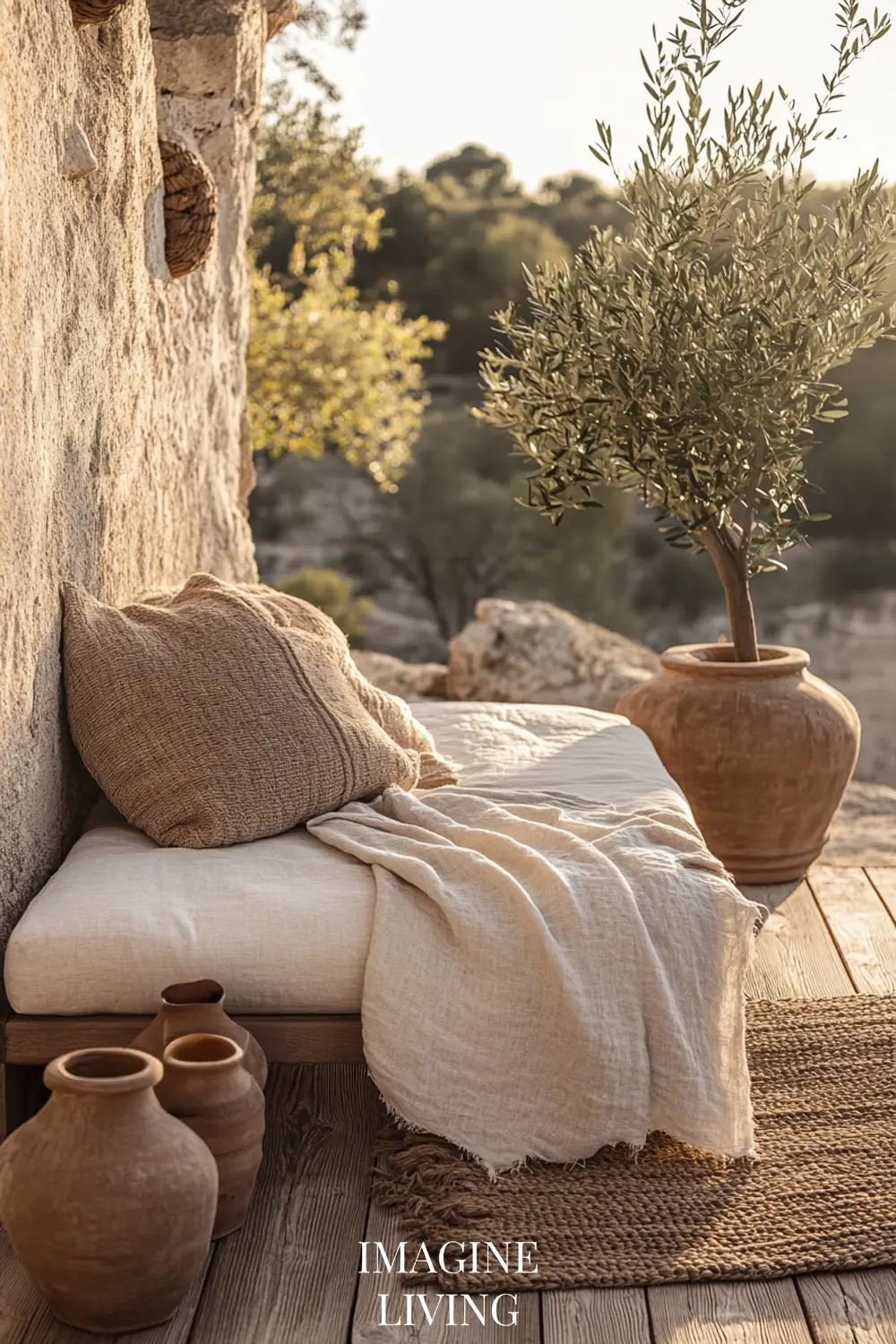
Key Elements of a Mediterranean Porch
Terracotta and Clay Tones:
Pots, tiles, and flooring in rich burnt orange, ochre, sun-warmed browns, and dusty rose hues.
Stone and Stucco Textures:
Walls in white or cream stucco, rough stone borders, or tile mosaics—everything reflects the light and carries an old-world softness.
Olive Trees and Herbs in Oversized Pots:
Large planters hold slow-growing greenery: rosemary, fig trees, sage, or lavender. The foliage is muted, silvery, and beautifully shaped.
Low Wood or Wrought Iron Furniture:
Carved wood benches, mosaic tables, or vintage iron chairs with linen cushions. Everything feels grounded and lived-in.
Earthy Textile Layers:
Thick linen throws, striped cotton cushions, and natural fiber rugs in warm, sun-faded tones.
Handcrafted Details:
Ceramic lanterns, weathered pitchers, hand-painted tiles—objects are artisan-made and timeless.
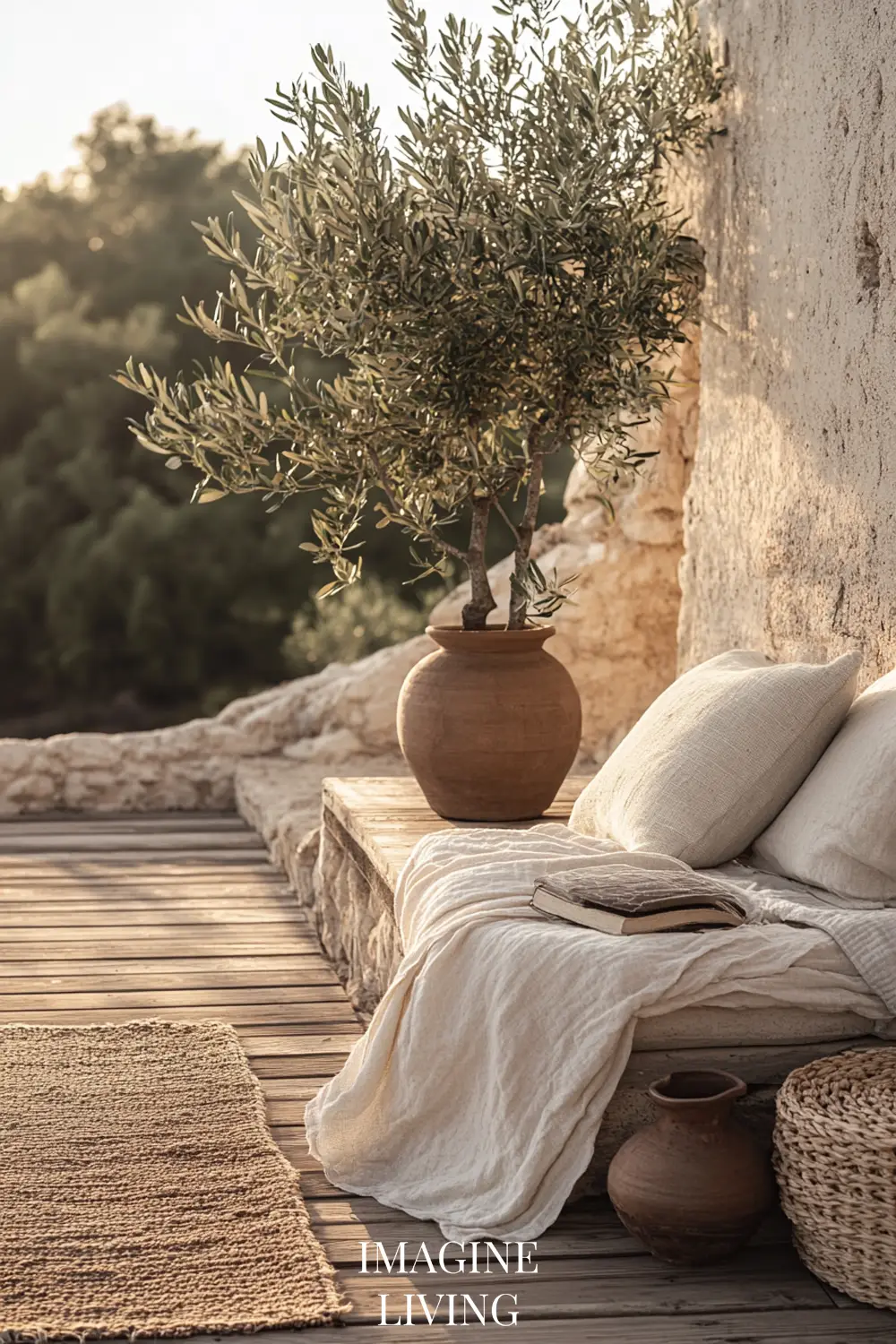
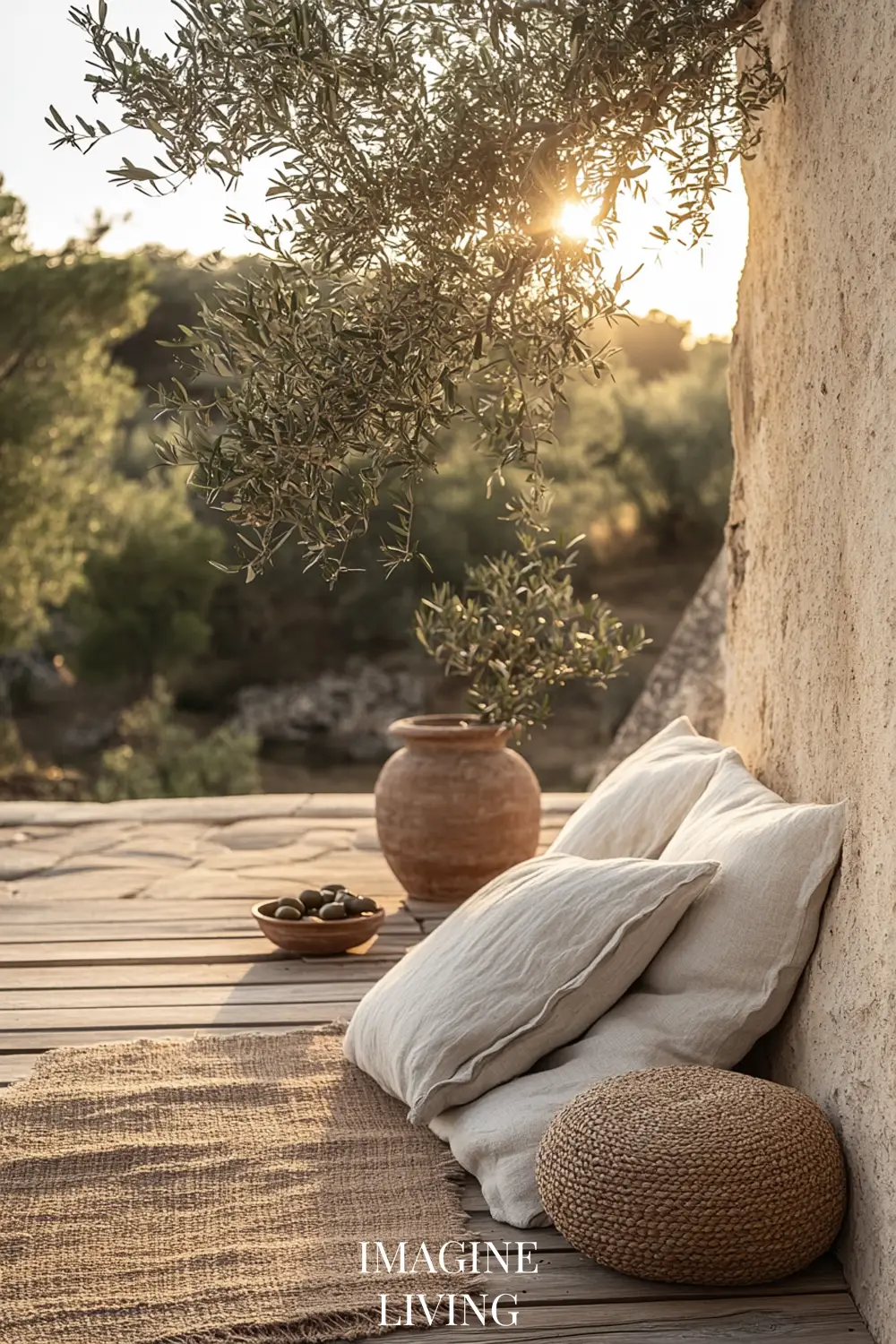
General Styling Tips for Mediterranean Porches
Let Texture Do the Talking
Mix stucco with linen, stone with jute. The contrast between rough and soft adds richness and depth to every corner.
Stick to a Sun-Warmed Palette
Think warm whites, sandy beiges, terracotta, and muted mustard or blush. These colors reflect the Mediterranean light without overwhelming it.
Bring In Artisan Elements
One hand-painted bowl or a rustic amphora adds far more than a dozen trendy accents. Choose meaningful, story-rich objects.
Create Cozy Zones
Use floor pillows, poufs, or a low bench with a rug to create intimate spaces within a larger patio or porch.
Let the Patina Show
Let things age. Unsealed terracotta will stain, olive wood will dry and crack, metals will tarnish—and it’s all part of the magic.
Mistakes to Avoid in Mediterranean Porch Styling
Using Too Much Gloss or Shine
Avoid anything lacquered, mirrored, or chrome. Mediterranean design is matte, porous, and deeply tactile.
Skipping Greenery
Olive, lavender, or rosemary in large clay pots bring life and balance. Their muted foliage complements the warmth of the palette.
Going Too Uniform
Mix materials, textures, and tones. The charm lies in the layers and age—not in perfect color matches.
Over-Styling with Trends
Avoid pieces that feel too modern or mass-produced. Keep your accents grounded in place, culture, and time.
Forgetting Comfort
Add soft layers for lounging. Mediterranean porches are built for afternoon naps, long dinners, and golden-hour conversations.
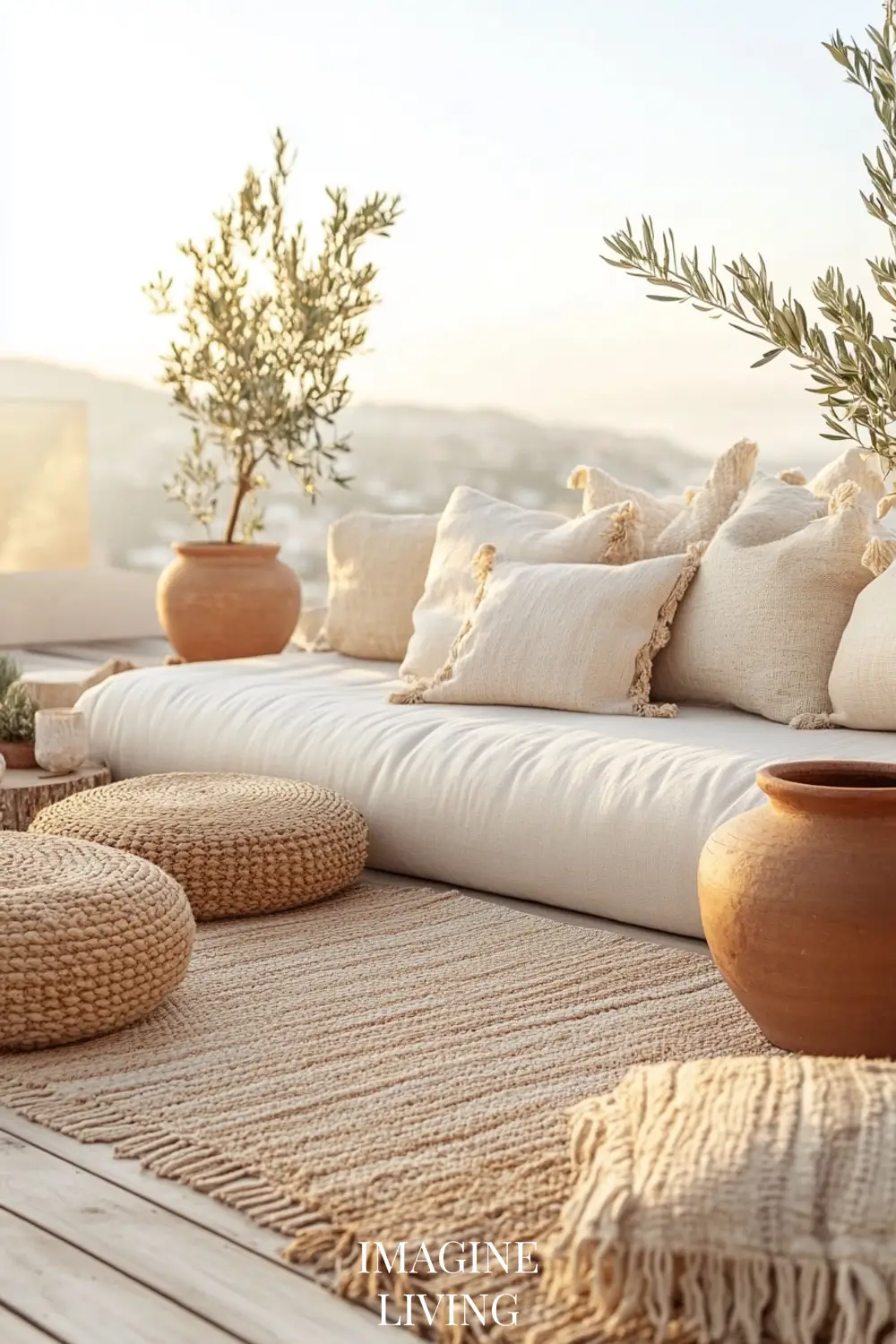
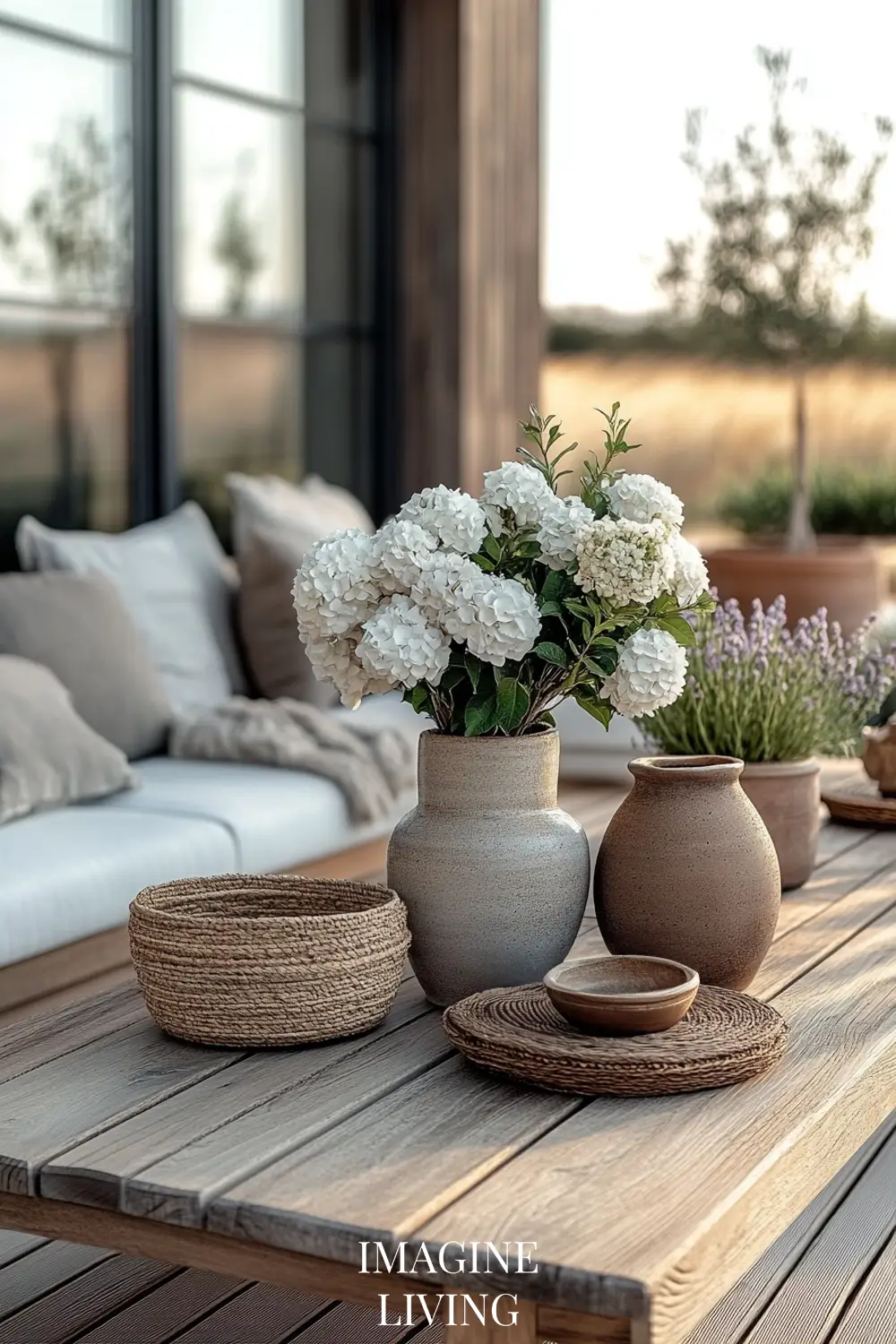
Final Styling Tips for Any Outdoor Space
- Layer Rugs: Start with a jute base, layer with something softer on top
- Use Levels: Stack books, group planters, and vary heights
- Add Scent: Lavender, rosemary, or scented candles elevate the sensory experience
- Plan for Evening: Lighting can completely shift the mood—add battery lamps, fairy lights, or even a small tabletop fire bowl
Mistakes to Avoid
- Too Much Matching: Let your space evolve naturally—mix textures and finishes
- No Shade or Shelter: Even a simple linen canopy or large umbrella makes your deck feel complete
- Overcrowding: Leave negative space so your eye can rest












